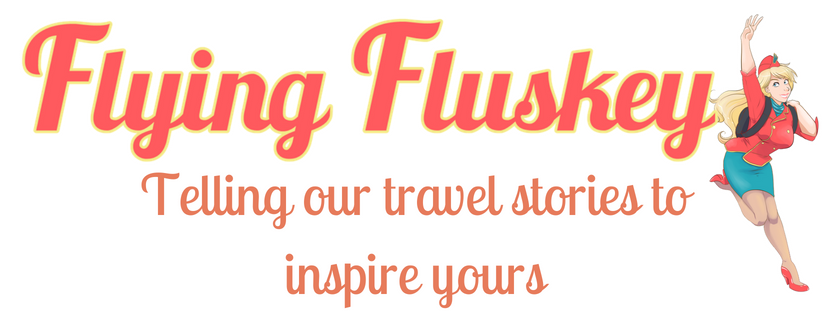Vienna is one of Europe’s grandest cities. It is blessed with stunning architecture dating back hundreds of years, iconic dinners and world-famous horses. If you only have a weekend in Vienna what should you see, and where should you eat, drink and chill to ensure you don’t waste your time? Never fear, we are here to show you how to spend 2 days in Vienna!
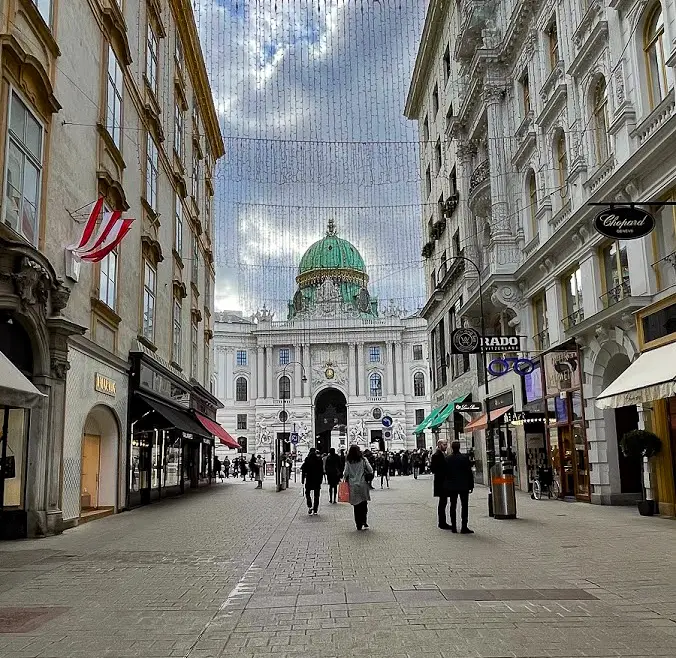
This post may contain sponsored content or affiliate links that help support the blog. All opinions are our own.
Contents
- A Little About Vienna
- When to Visit Vienna
- How Many Days for Vienna?
- 2 Days in Vienna – Day One, The Ringstraße
- Dr. Karl Lueger Platz
- Museum of Applied Arts (MAK)
- Stadtpark
- St Charles Church/Karlskirche
- Vienna State Opera (Wiener Staatsoper)
- Monument Against War and Fascism
- …The Palmenhaus
- Parliament Building & City Hall (Rathaus)
- Glacis Beisl
- A Classical Music Concert
- 2 Days in Vienna – Day Two, Palaces and Ponies
- Schönbrunn Palace
- St Stephens Cathedral
- Lamee Rooftop Bar
- The Plague Column
- Buffet Trzesniewski
- The Spanish Riding School
- Demel
- Prater & The Wiener Reisenrad
- Bitzinger Wurstselstand
- Final Thoughts on Your 2 Days in Vienna
A Little About Vienna
Vienna is the capital of Austria and is known as the Imperial City. For almost four hundred years (1558 – 1918) Vienna was the capital of the Habsburg (Austo-Hungarian) Empire. This included modern-day Austria, Hungary, Slovakia, Slovenia, Croatia, some of Poland and Romania and even a little of Italy. This is why it seems so strangely tucked in the far east of the country. It used to be in the west of the vast empire and through its break up after WWI it now lies further east than Prague (considered by many to be Eastern Europe). You’ll see an awful lot of grand buildings from the 1600-1800s and it makes the city so magnificent to walk around. If you like your walks a little greener, despite not being in the Alps, the foothills are nearby so it doesn’t take too long to be on a pretty hillside. In fact, just north of town, you’ll find several vineyards with views over the city.
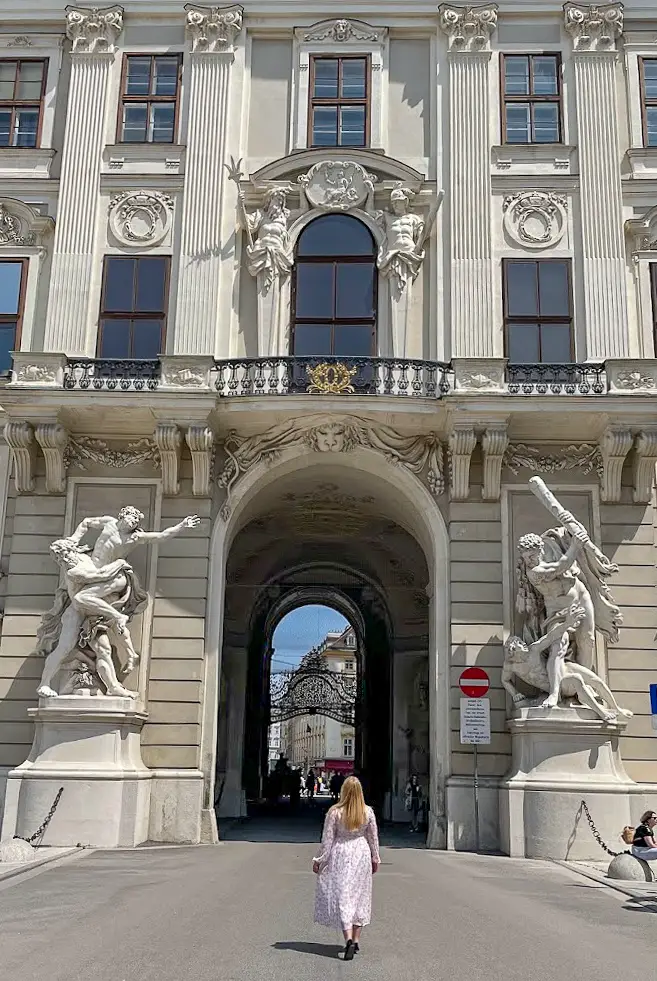

When to Visit Vienna
Vienna has a few distinct tourist seasons:
- If you visit in January/February it is ball season. You can buy a ticket and as long as you adhere to the dress code, you are free to join one for waltz or two.
- In spring, cafes open up their shop fronts and rooftop bars reopen for the sunny season.
- Summer sees tourist numbers swell and locals picnicking on the grassy spaces in the city or travelling out to nearby vineyards for some wine and charcuterie.
- In October the long night of museums is a must for culture vultures. Galleries stay open late and many serve drinks or snacks as you go around. Plus, the very seasonal, very local drink of Sturm is served. It is grape juice that is only partly fermented so blink and you’ll miss it.
- In late November/December it is Christmas market time and the city is decorated with twinkling lights.
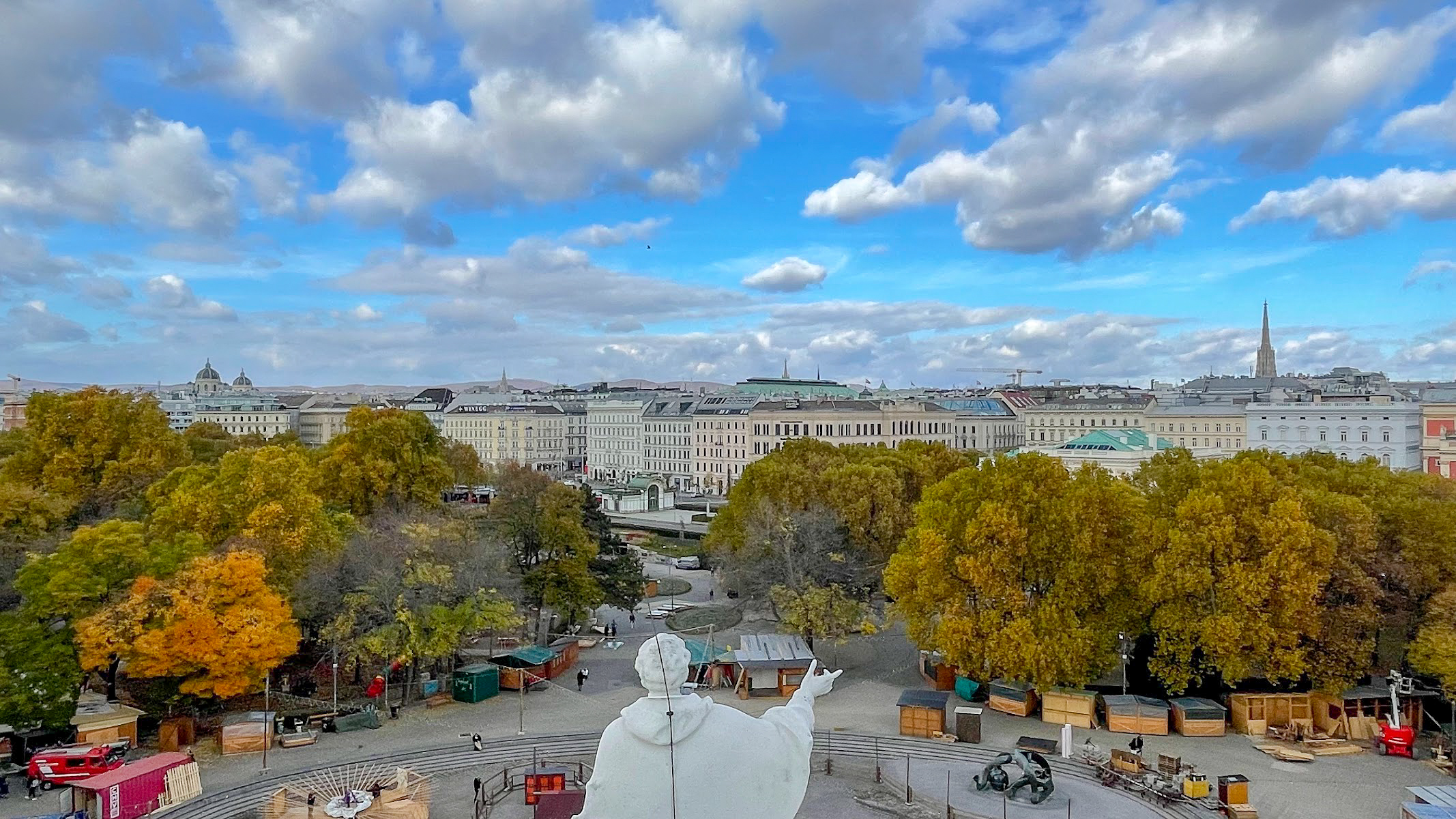
How Many Days for Vienna?
It is possible to see lots of the main sights of Vienna in one day but it will feel rather rushed. It also doesn’t really give you time to go into any of the museums or to eat enough of the delicious dinners on offer. With 2 days in Vienna, you can take a little more time. It allows you to head out to the slightly further away sights like Schönbrunn Palace, or stop for a drink/torte for a while without getting those itchy sightseeing feet. A long weekend is probably best, with that extra half day afforded by arriving on Friday afternoon or leaving on Monday afternoon. This means you can visit a vineyard in warmer weather or if you have a whole day, catch a boat to nearby, Bratislava (the capital of Slovakia).
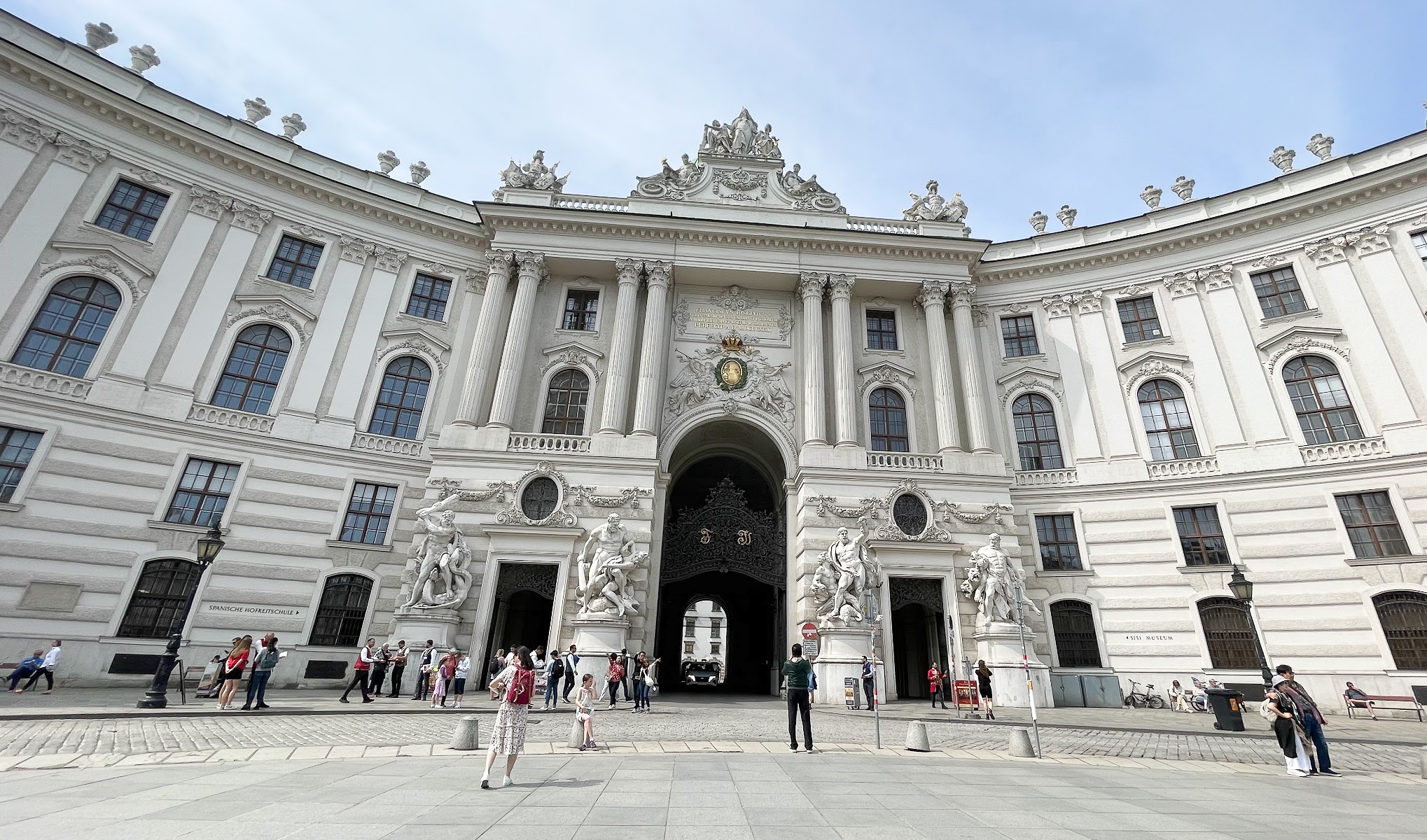
2 Days in Vienna – Day One, The Ringstraße
A quick disclaimer, you will not have time to go in and out of museums all day so I would pick one or two that you really want to explore.
The Ringstraße (Ringstrasse) is a semi-circular road that surrounds the old centre of Vienna. It was laid out in 1860s is lined with beautiful buildings. For a super speedy way to see it, hop on a tram We have a bit more time though so let’s take a walk around it and see the prettiest or most interesting points along the way.
Dr. Karl Lueger Platz
Start your day at Dr. Karl Lueger Platz. In the centre of this square is a statue. This has been the subject of debate, a focal point for protest and a bit of a conundrum for the city for years. The statue depicts a former mayor of Vienna who was rather right-wing, and actually a bit of an inspiration for one Adolf Hitler. His political, anti-semitic views were extreme. In June 2023 (just after these photos were taken) and almost 100 years after the statue was erected, the decision was made about what to do with it. The city has decided to tip it 3.5 degrees to the right, giving the viewer an uneasy feeling, It is another interesting take on the worldwide debate on what to do with statues of people with uncomfortable pasts.
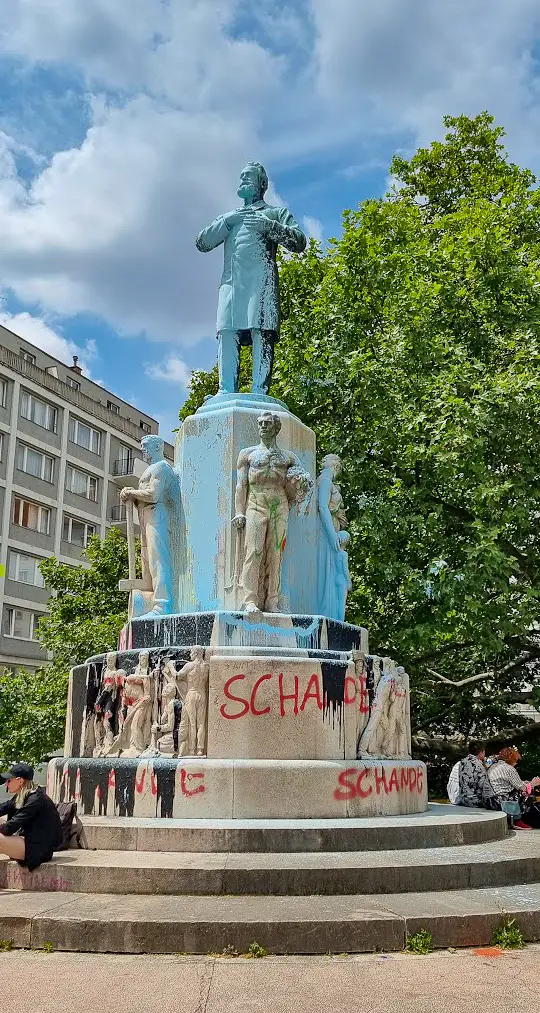
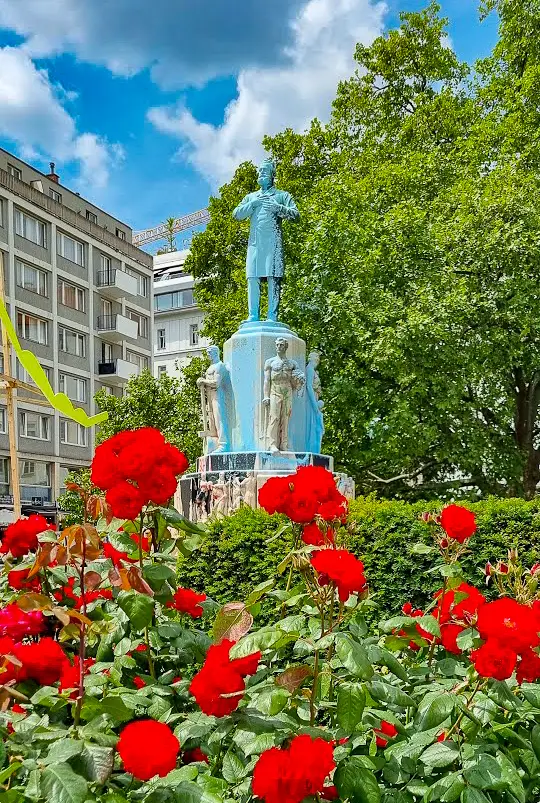
Museum of Applied Arts (MAK)
MAK is to Vienna, what the V&A is to London, the city’s museum of design. The museum covers the history of Austrian design over the last 400 years from baroque candlesticks to intriguing wooden furniture, to the proliferation of “isms” over the last century. The building itself was designed in 1871 by Heinrich von Ferstal and the neo Renaissance building, especially its ceilings and stunning atrium are a fitting spot for a design museum.entry to the shop and the restaurant does not require a ticket, but bear in mind that this is not a casual museum café, instead of rather upscale restaurant, so if you want a casual cuppa head across the road.
Opposite MAK, Cafe Prückel is a quintessential Viennese coffee house. Possibly a better option to sit and sip a quick hot beverage. It opened in 1903, but now has a mid century interior, giving it at once a casual and wooden clad formal atmosphere. Here you’ll find strudel-scoffing students, newspaper perusers, and coffee connoisseurs, all enjoying their mornings.
Stadtpark
The 28-acre Stadtpark is a popular place for a wander, its meandering paths crossing the Wienfluss (Vienna River) and winding around many a statue. The glimmering bronze Johan Strauss is a stand out so but the penguin fountain might be my favourite. There is also a wonderful old weather station from 1813 which tells the chance of rain and temperature amongst other things. It is fun to compare it to your phone’s weather app.
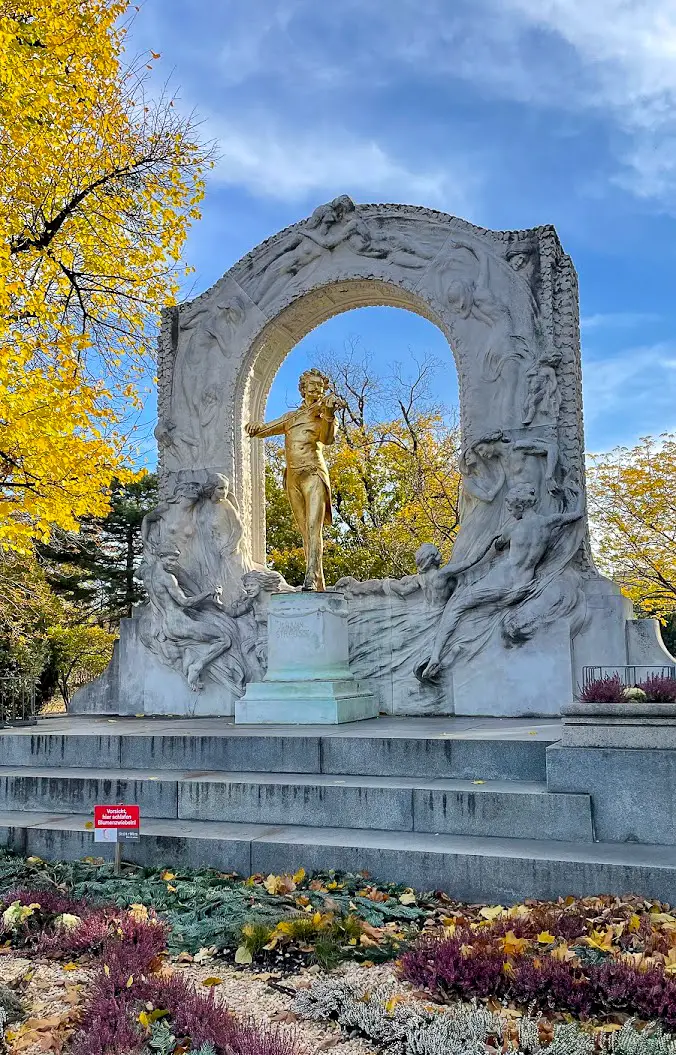


St Charles Church/Karlskirche
On the south side of Karlplatz (always exciting with a Karl in the team) is St Charles Church. You need to come a little off the main road but it is worth it for Vienna’s most beautiful baroque church. Karlskirche was commissioned by Charles VI in the 1700s and although the interior is very baroque, the outside is more eclectic. The facade is a pleasingly symmetrical combination of thick baroque towers, thinner columns based on Ancient Rome, a temple-style facade modelled on ancient Greece and a nice, big dome. It is a very interesting mix of styles but works so well.


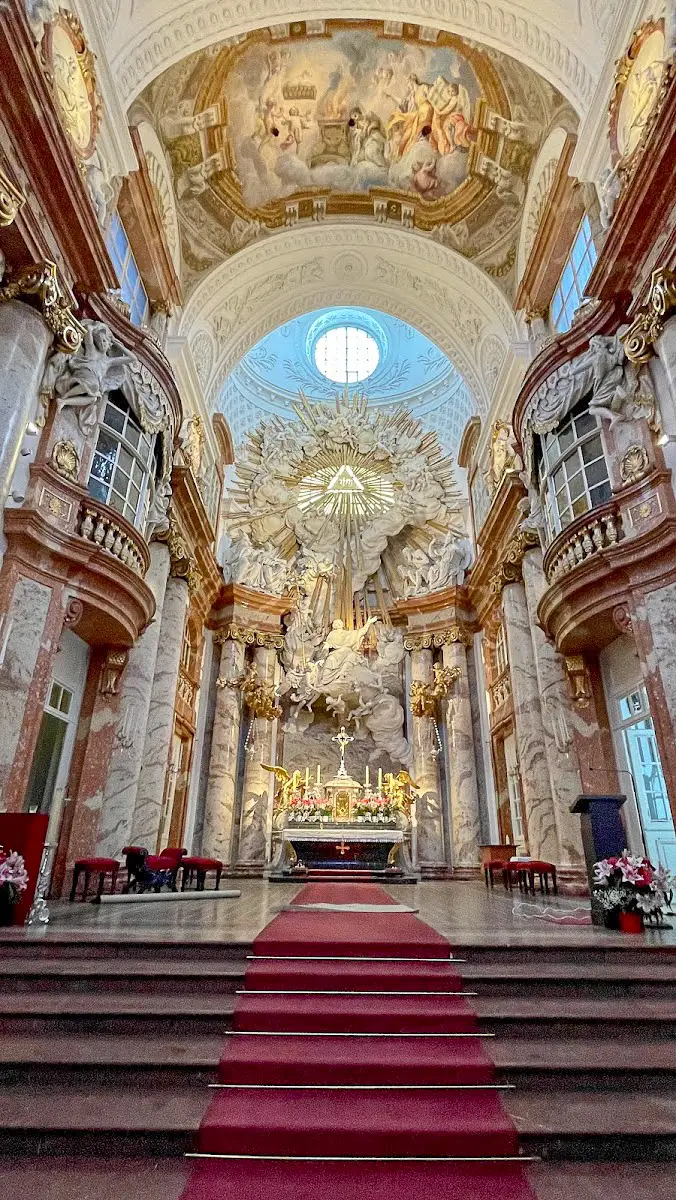
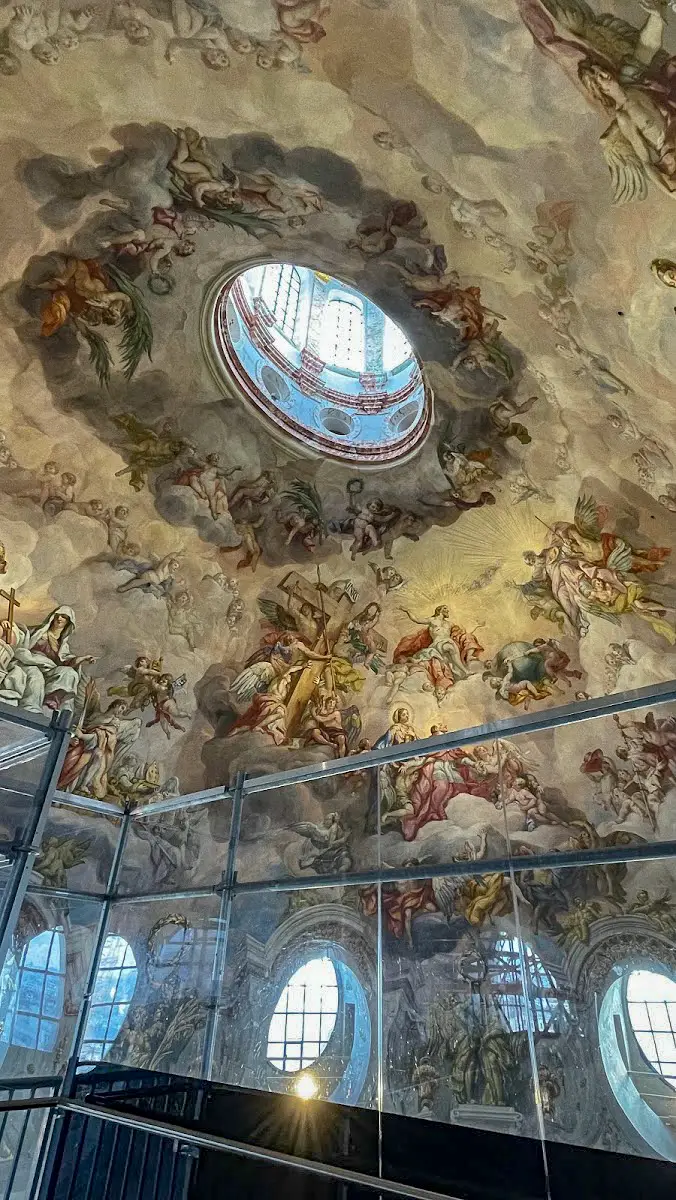
Inside, coloured marble glows in the daylight, huge paintings dazzle the senses and the theatre box style sides of the church covered in scrolling are seriously curvaceous. To get a closer look at the ceiling you can take the slightly terrifying lift. This elevator whisks you right up the top of the church and there is a crazy view down. You can also take the stairs up to the organ and out onto the panoramic terrace which has lovely views across the centre of Vienna.
Vienna State Opera (Wiener Staatsoper)
Up there as one of the most famous opera houses in the world, Vienna’s State Opera history is esteemed. The building opened in 1869 and has played host huge operatic spectaculars, pretty ballets and concerts galore. Inside, red velvet seats adorn and arena of boxes. The incredible foyer is bedecked with stunning carvings and grand statues. The stage now has around 360 performances but you can organise to just take a tour if you can’t snag a ticket.
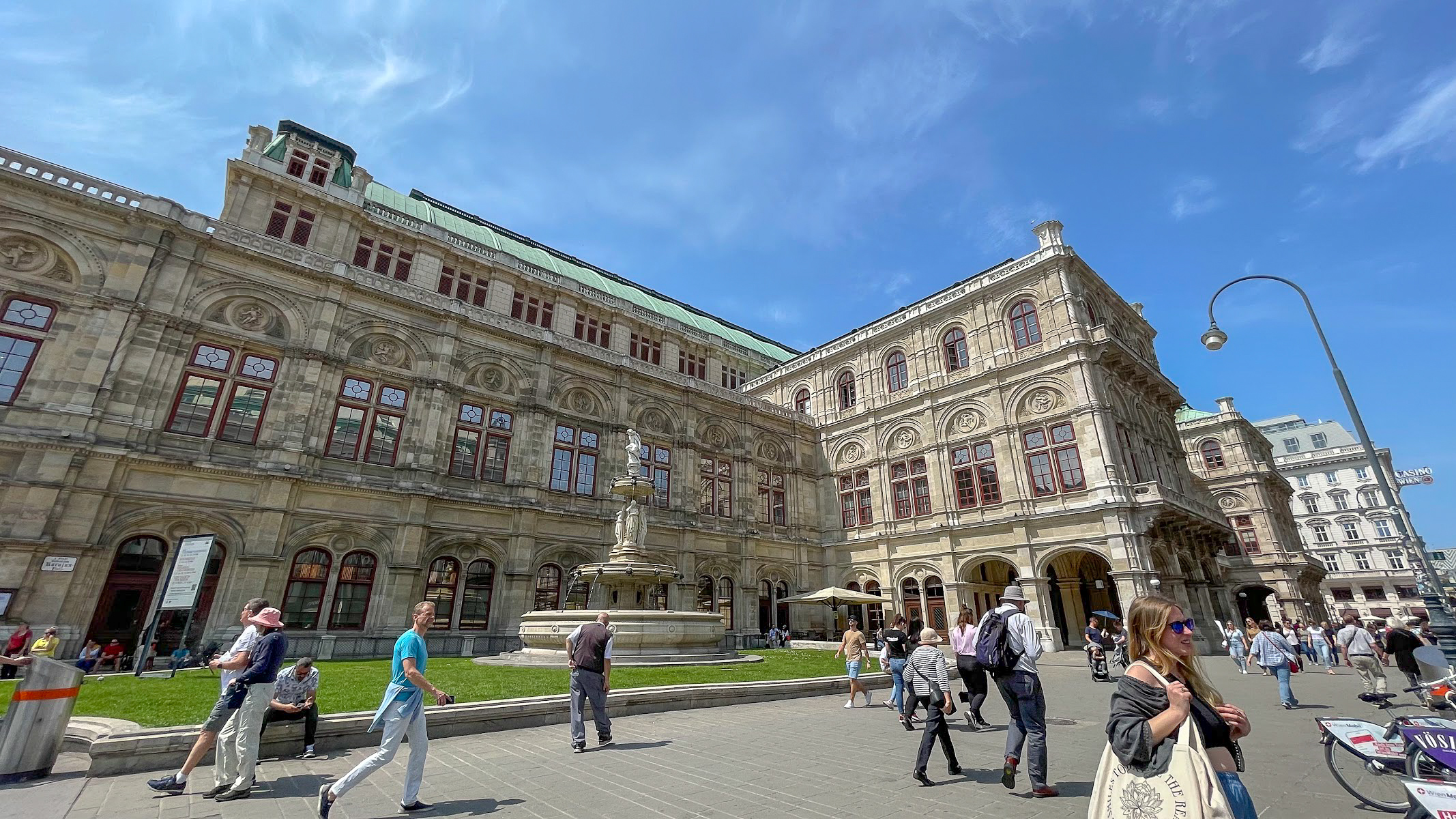
You can buy seated tickets on the website but if you are on a budget there are around 500 standing tickets to many performances which are much cheaper. You can register for these online ahead of time. Alternatively,, if you are feeling spontaneous, get in the queue on the Operngasse side of the building. Get to the line for the Stehplatz-Kasse (Standing Area) around 2 hours before the show and you can purchase a ticket a little after.
Monument Against War and Fascism

In a city full of baroque palaces and grand churches, the Monument Against War and Fascism is an extreme contrast.
It stands in the middle of Albertinaplatz, look for the rocks. The open space here was created by a WWII bomb that demolished a building a killed hundreds. The statues were installed in Albertinaplatz in 1988 by artist Alfred Hrdlicko as part of Vienna’s “Year of Reflection”. It looks back at all the victims of war and fascism throughout the city’s history but particularly when the city was under Nazi rule. The more you look at the four sections of the monument, the more the dark roots of the sculptures are. We will let you explore it by yourself but do take the time as it is a deeply intricate and moving memorial.
Across the road, pass the Bitzinger Wurststand towards Burggarten. Don’t worry, you will have another chance t try these bangers. Instead, we are heading for lunch at ….
…The Palmenhaus
The Palmenhaus is a large Victorian glasshouse that sits at the top of Burggarten. In one wing is a butterfly garden, the other is empty and in the middle is the Palmenhaus brasserie. This is the perfect place to come for lunch with plenty of natural light streaming in. If you sit inside you can spot the butterflies flitting by the windows as you eat. The fare is Viennese with a focus on seasonal dishes. The white asparagus and smoked salmon dish was a summer-tastic delight. The burger was cooked perfectly medium and the wedges were top-notch. Nothing on the lunch menu is heavy …or cheap, so you and your wallet will both feel light when you leave. They have a lovely, long wine list but stick to one or two, it is only lunch and we have a whole afternoon of sightseeing left.
After lunch, take a moment to walk through the Burggarten and find the Mozart statue.


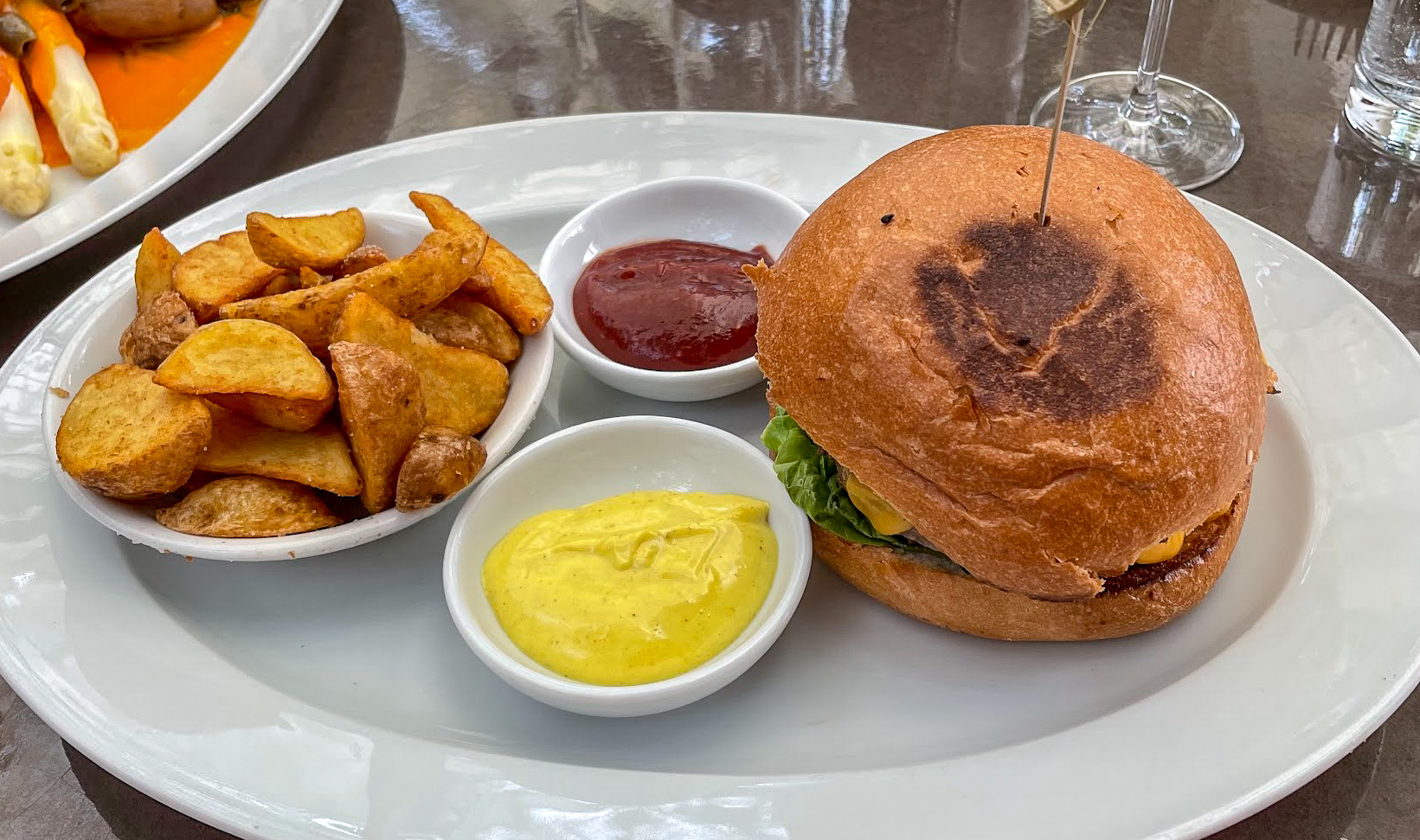


OK, here is where the afternoon gets complicated. We are about to enter the Hofberg Palac complex which sits opposite the Museumsquartier (museum quarter). If you visited every corner of every museum here, you are looking at a good few days. Instead, you should either pick one from this list and take your time or pick two and whizz to the specific galleries that interest you.
- Imperial Treasury Vienna – If bling is your thing, then head to the Treasury. This large collection of secular and religious treasures is stuffed full of shining gold and glittering gems. Here you can see the Habsburgs crown jewels, including the Imperial crown, orb, and sceptre. On the religious side, the imperial crown of the holy Roman Empire doesn’t fail to delight.
- Weltmuseum Wien – The Weltmuseum is full of anthropological collections, obtained by the Habsburgs from across the Empire and beyond. As well as being an amazing collection of International curiosities, it does a great job of sparking debate about colonialism.
- Museum of Modern Art Ludwig Foundation Vienna (MUMOK) – A huge modern art museum that is a work of art itself. There aren’t many paintings here, instead the galleries are full of abstract pieces, sculptural works and more exporational art.
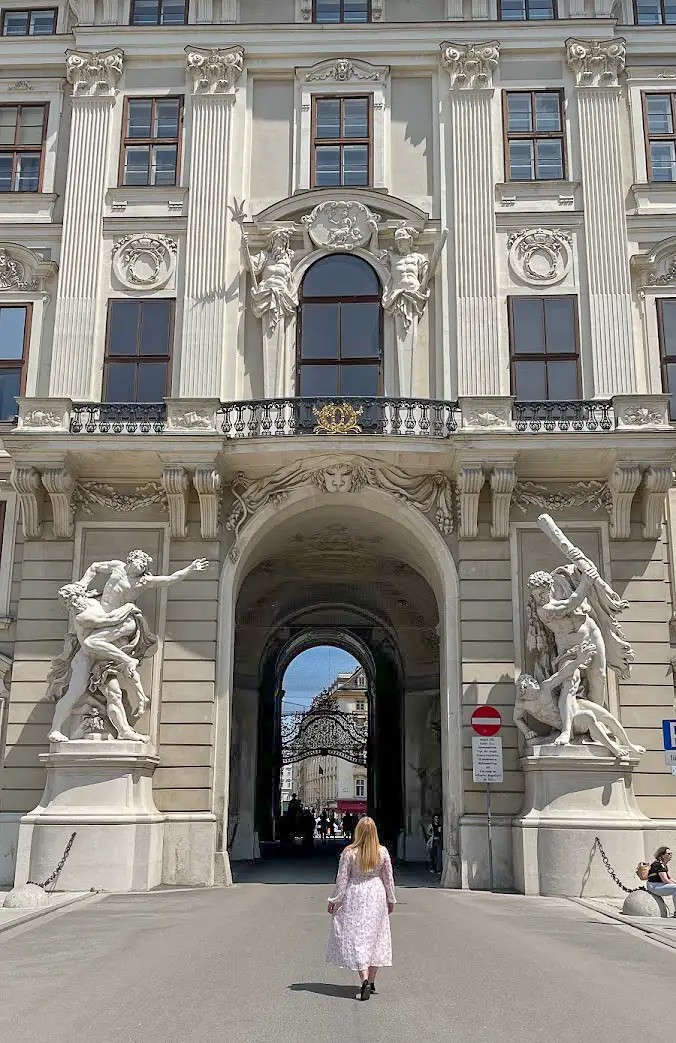


- Kunsthalle – The word Kunsthalle means temporary art exhibition, and this is what separates it from normal art, museums. The controller Vienna does not have any permanent exhibitions, instead, it focuses on new, evolving modern art from across the world and the debate that comes along with it. Expect challenging pieces and plenty of mixed media.
- Albertina Museum – This is a wonderful graphic art museum housed in an 19th-century Habsburg palace. There is a large collection of architectural drawings, rings and paintings, some of which are so rare and delicate that they are only taken out for display once in a decade.
- Leopold Museum – The collection of modern Art in the Leopold museum is crowned by the many works of Egon Schiele. They have 40 of his paintings and over 150 of his drawings. For another brilliant view of Vienna, take the stairs up to the rooftop which is free without a ticket and a nice place to take in the surrounding area.
- Kunsthistorisches Museum – The first of two museums that stand opposite each other, either side of the Maria-Theresien-Platz, the consideration is a museum of fine art whose interior is almost as beautiful as the artwork is it contains. There is a beautiful rotunda, surrounded by granite floors, marble, columns and grand murals. In the galleries, you will find Masters, such as Rubens, van Dyke, Canaletto, Klimt, and the largest collection of Bruegel in the world..
- Museum of Natural History – On the other side of Maria-Theresien-Platz is the Natural History Museum. This lays claim to the largest collection of meteorites in the world, some very cool dinosaur skeletons, and a limestone figurine of the Venus of Willendorf that is over 29,000 years old. Walking around the building itself is interesting enough as it has carvings of figures associated with natural history…all in German of course, so you will have to do some translating.
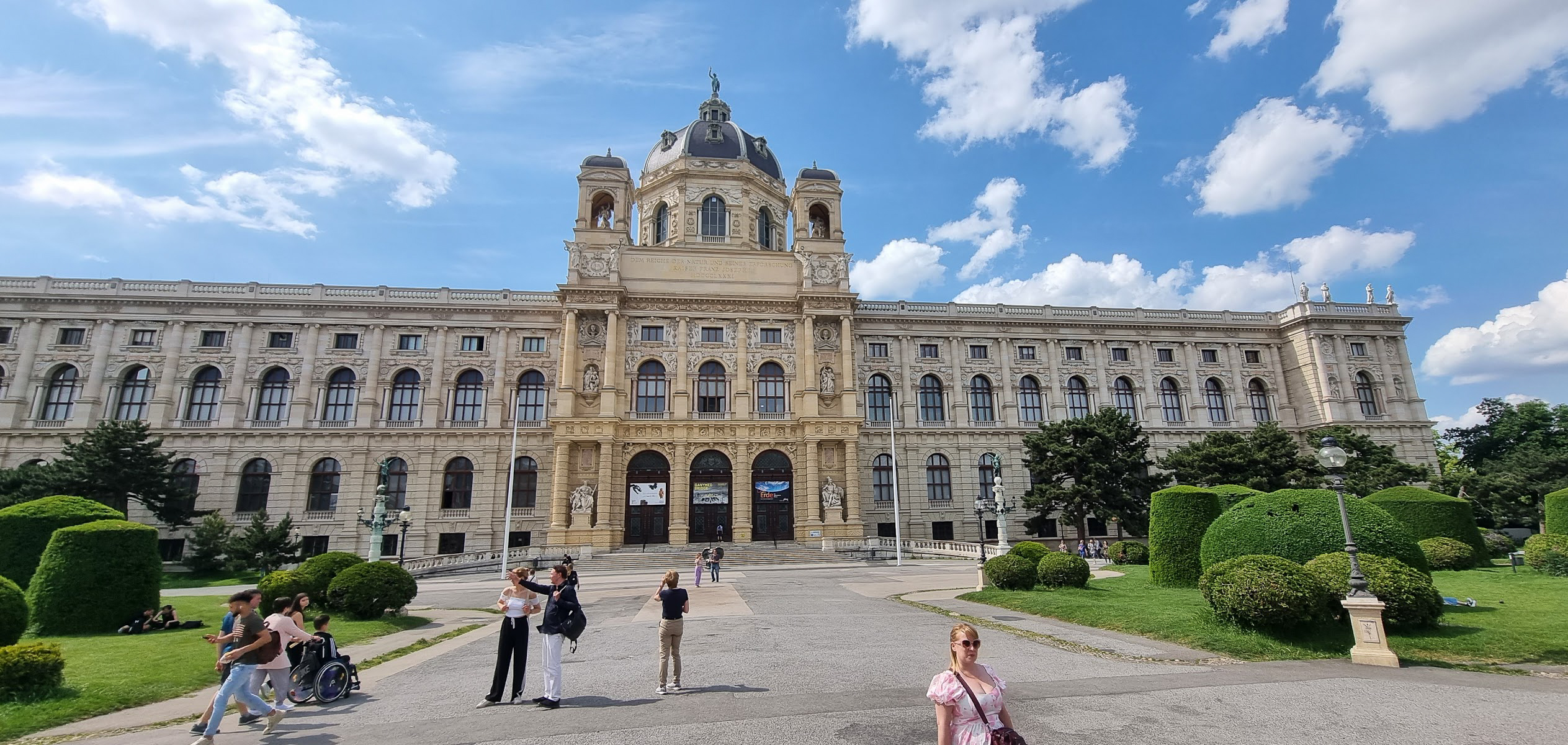
Parliament Building & City Hall (Rathaus)
Just a little further around the Ringstrasse are our last stops. Take in the grand Austrian parliament building’s impressive neoclassical architecture. The striking white façade dates from the 1880 but the Greek revival style feels like it could have been built any time in the last 2000 years. The magnificent 5m tall Athena fountain that stands outside is topped with a gleaming golden crown. She is carrying a spear in one hand and a miniature statue of Nike (goddess of Victory) in the other. Below Athena are two females figures representing legislative power and executive power. Below them are the gentlemen that represent the four important rivers of the Austro-Hungarian empire.
Oh, and the cupids riding dolphins? They are just cupids riding dolphins.
The last sight is the City Hall. This was built around the same time as the parliament building but in a distinctly different style. It is designed in high gothic style with towers like a cathedral. Right at the top of the almost 98m steeple is Iron Rathausmann, a symbol of the city. This medieval soldier may be so small that you almost can’t see him in our photo, but he is quite large in reality at 3.4m tall, 650kg and with a shoe size of 63!



Glacis Beisl
For a chance to try traditional Austrian food in a modern and relaxed atmosphere, head to Glacis Beisl. In warmer months you can sit in their large, leafy beer garden, and when it is cooler, they have a sleek dining room with plenty of glass that is actually 300 years old. This is a brilliant place to try Vienna’s most famous food export, one that is named after the city in fact, the Wienerschnitzel. A traditional Wienerschnitzel consists of a piece of veal, cut thinly and then bashed until it is even thinner. It is then coated in flour, egg and breadcrumbs before being fried in lard or clarified butter. As the breadcrumbs aren’t pushed into the meat, it all puffs up, creating a unique bubbly, crisp texture. It is served with some lemon to cut through the richness and usually some sort of potato salad or slaw on the side. Pair it with a glass of wine or beer from their extensive drinks list and you’re onto a winner. Just remember, if you opt for the linen tablecloth, napkins and bread, you will have an extra cover charge so to save some pennies, go for the informal tables.
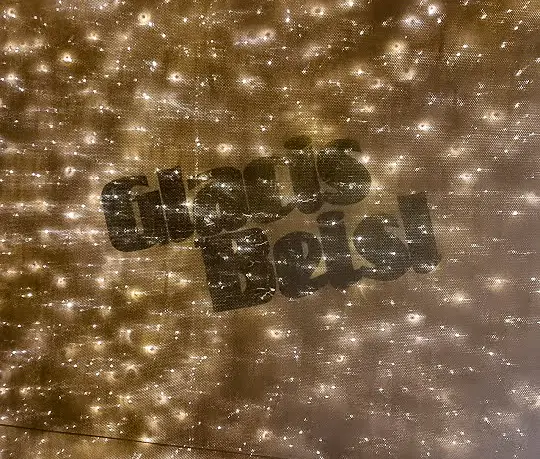

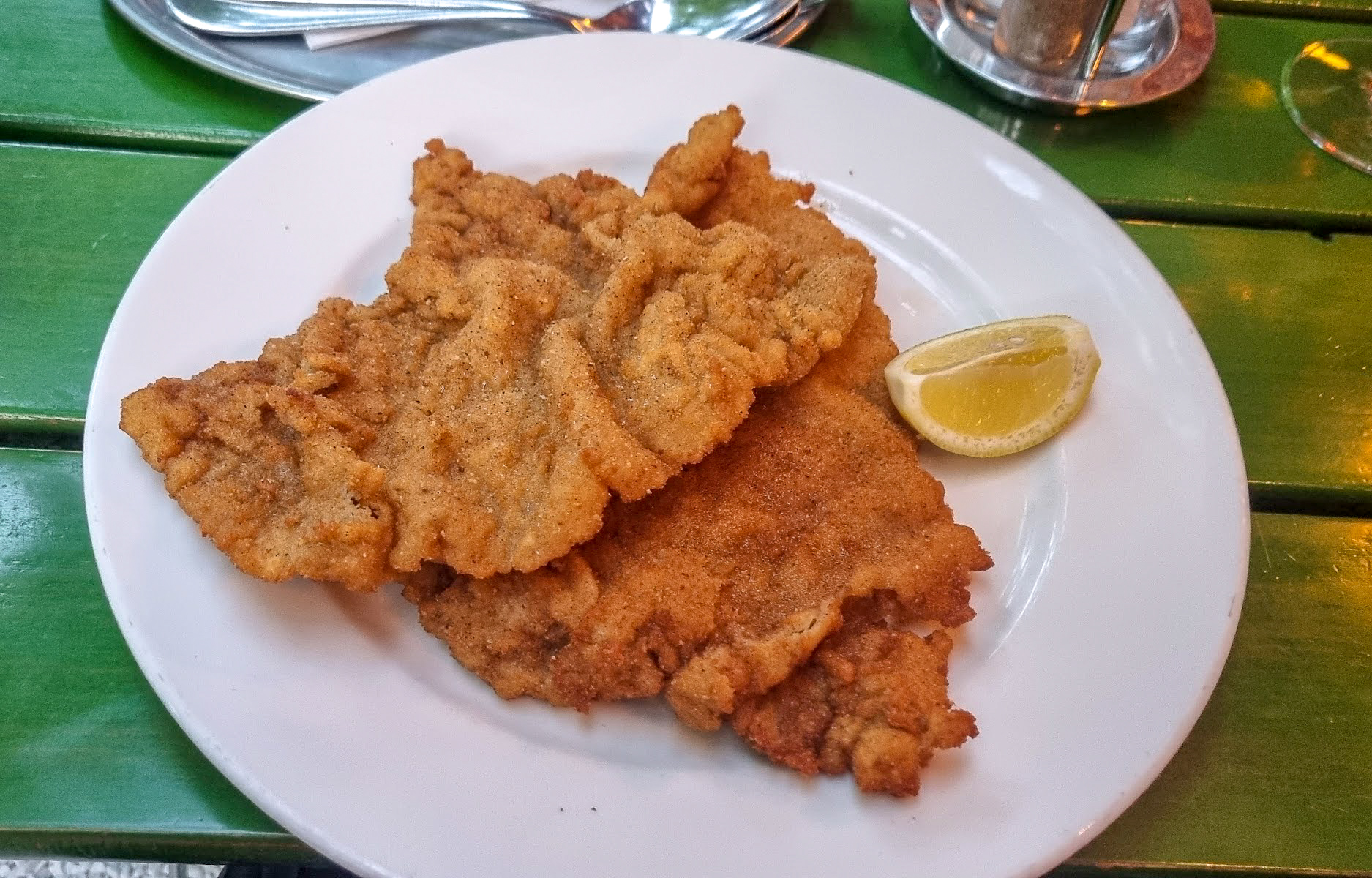
A Classical Music Concert
No trip to Vienna would be complete without a little music. Luckily, there are about a billion concerts that take place everywhere across the city, every day. You won’t fail to see the ticket sellers in the centre of town, especially around the opera house. You can see who has the best pitch or you can book something in advance to ensure you get exactly what you want. The most popular concerts are of course homegrown talents Mozart or Strauss but you can pick whichever classical music makes you happy!
2 Days in Vienna – Day Two, Palaces and Ponies
Schönbrunn Palace
Schönbrunn Palace was originally constructed in the 1500s as a hunting lodge (as all good palaces were). In 1683, Emperor Leopold I gave it some extensive renovations and added some pretty formal gardens. Then, in the 1700s, Maria Theresa completed an extensive renovation and it became the official summer residence for the Habsburgs. The gardens were extended and beautiful follies were added for the family’s entertainment.
Schonbrunn Palace is vast at a smidge over 31,000m2. It is the largest palace in Austria. The imposing width of the palace speaks to the breadth of the empire. The standard ticket gives visitors entrance to the staterooms. The Rococo-style gilded hall of mirrors is particularly majestic and once played host to a precocious little six-year musician, called Mozart. The other great gallery, The Great Gallery, is decorated with impressive murals which burst with Rococo glam.
Some of the prettiest rooms are in the second part of the tour but this is much shorter so there is a balance of time, price and interest to be considered.

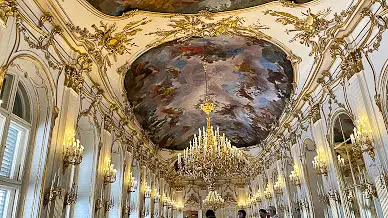
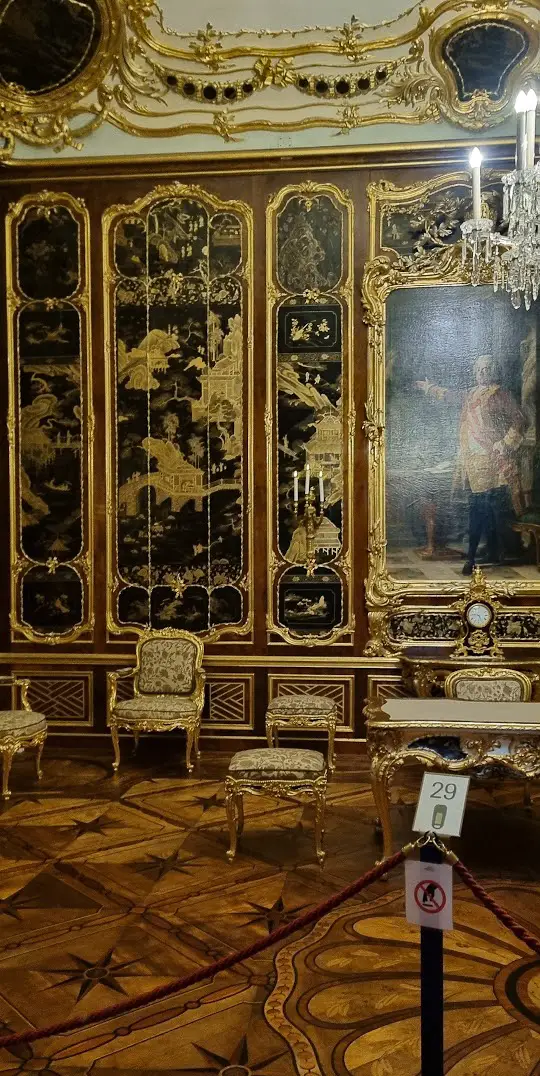
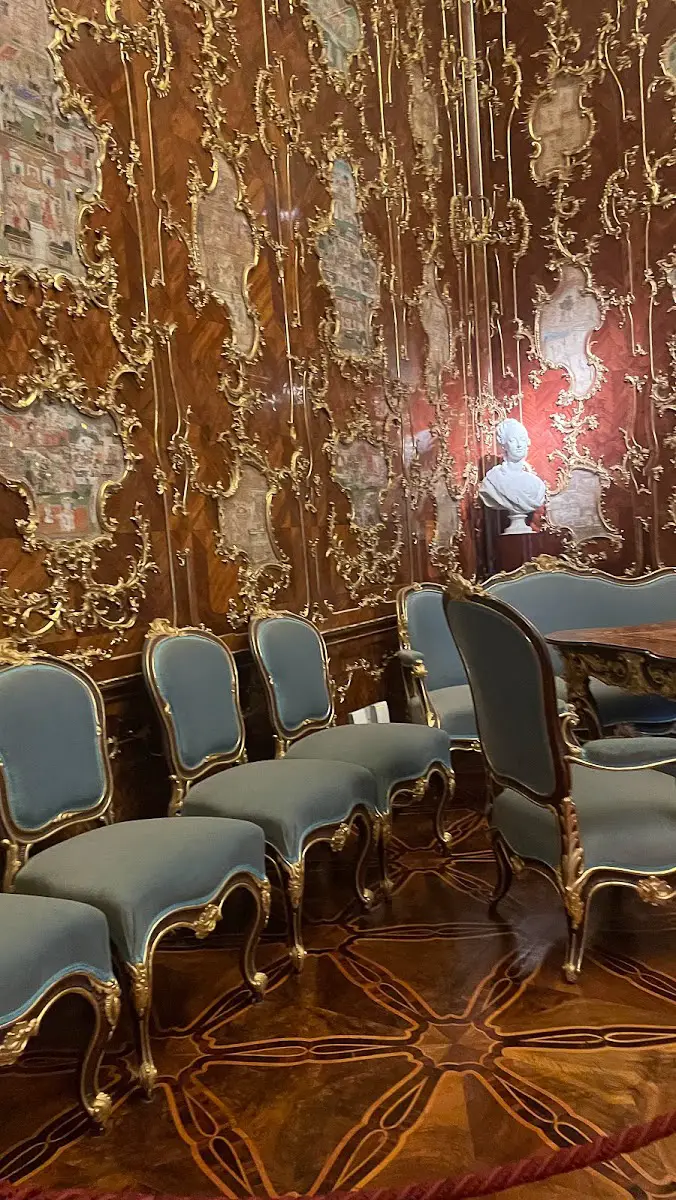
Make your way behind the building to the gardens next. The large formal gardens behind the palace, are many times greater than the palace itself, as huge as that may be. The gardens are mostly free and open to the public so you will see a few joggers weaving their way through the tourists. You could lose an entire day exploring between the hedges and along the paths but here are some highlights that we think I worth searching out.
- The Arboretum – Perfect for the ‘Gram.
- The Neptune Fountain – The most extraordinary of Schonbrunn’s fountains depicts the god Neptune holding court over his soldiers riding seahorses. You can walk up and behind the fountain and see it up close which is cool
- The Maze and Labyrinth – There has been a maze at Schonbrunn since 1720. The smaller of the mazes you can explore is based on the original. The larger, The Labyrinth, is all new and full of fun games and surprises. (Additional ticket required).
- The Rose Garden – The Rosarium has a huge selection of roses to stick your nose into and enjoy. It isn’t huge but the sheer variety of roses means it is worth seeking out.
- The Zoo – This is the oldest working zoo in the world. Of course the conditions for the animals have greatly improved since its conception but it is nice to see some of the original 18th century buildings still in operation. (Additional ticket required).
- Roman Ruins – These ruins are fake news…but that doesn’t make them any less impressive. In an era that loved follies in the garden, this may be the best folly in the world. The ruins are based on the Temple of Vespasian and Titus.
- The Gloriette – Climb the 60m hill to the glorious Gloriette. This folly-cum-summer house is a large, attractive construction that was added in 1775 to improve the view from the palace (or so it is said). It has the feel of a triumphal arch and some lovely sculptural detail when you get up close. Plus the view from up here to the palace and the city is wonderful. From here you can make your own way back down through the gardens or hop on the land train that comes every half an hour (€8 for adults, €4 for reduced mobility).
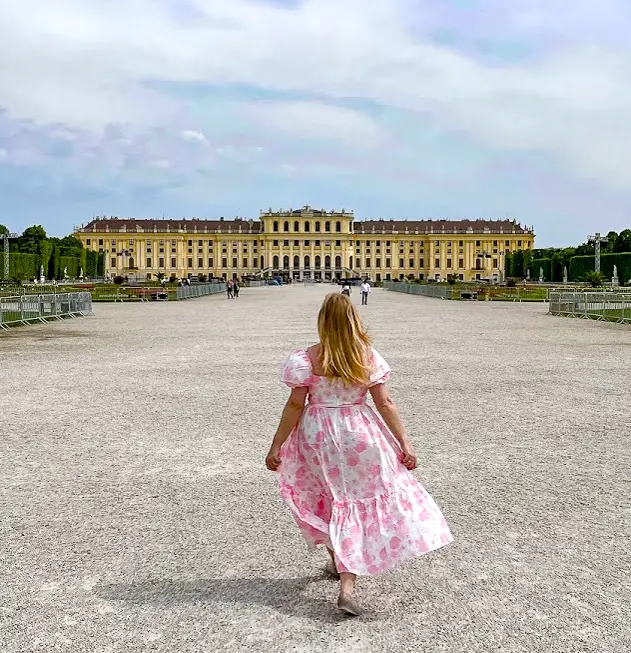
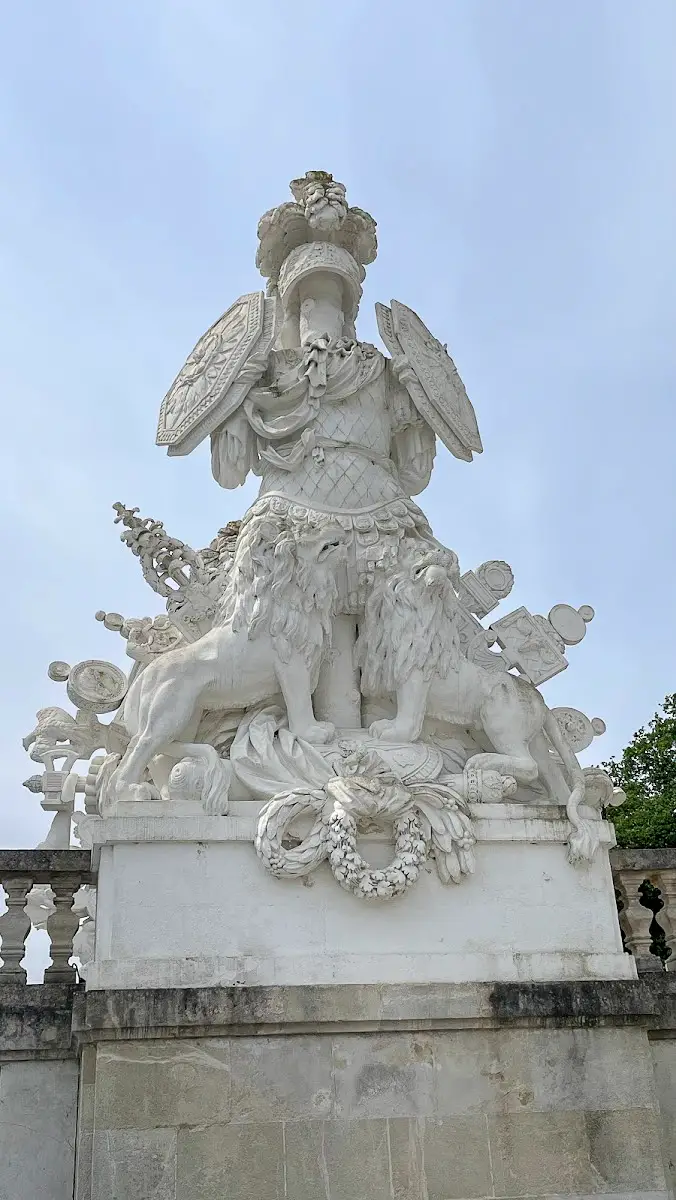
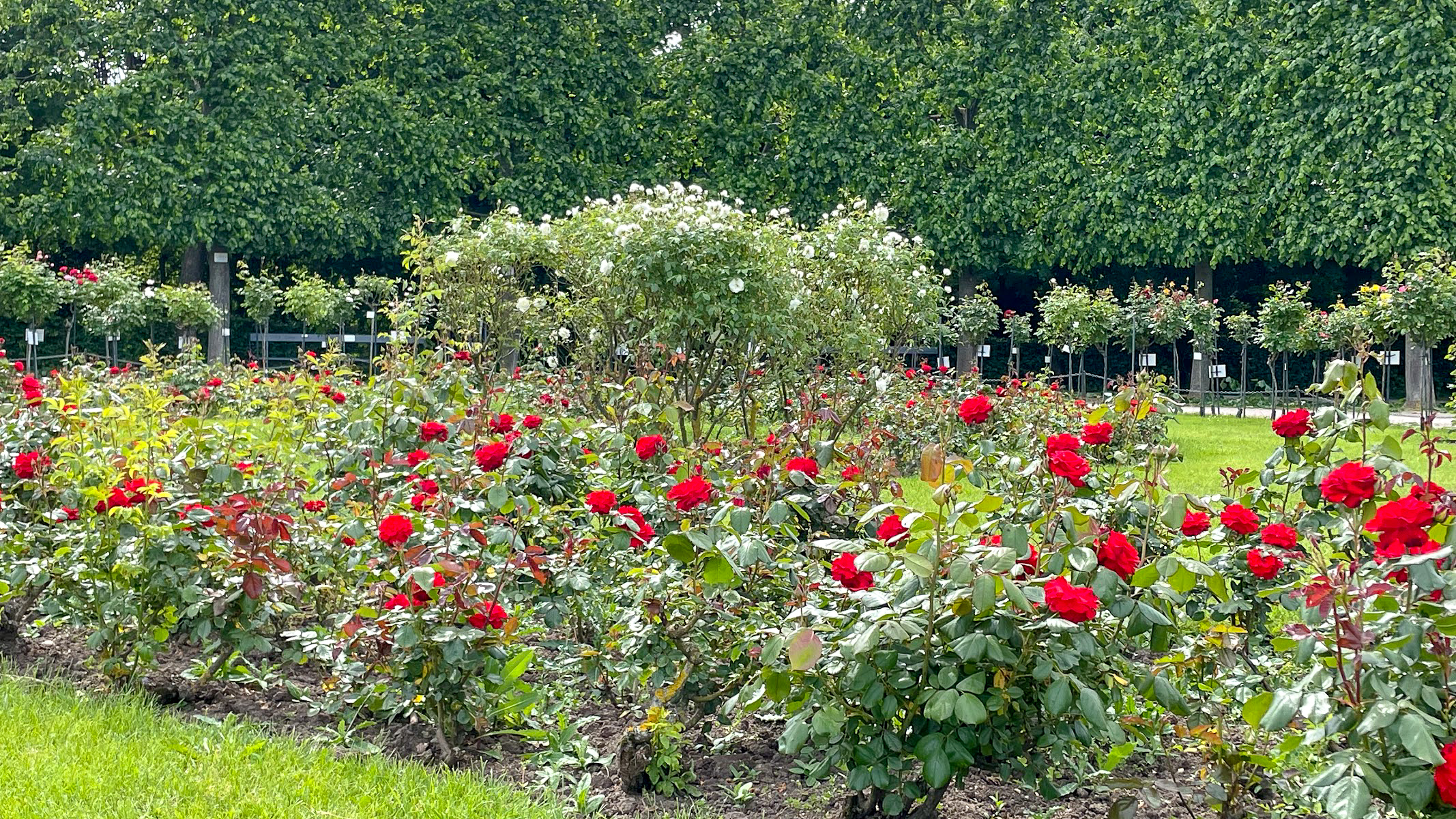
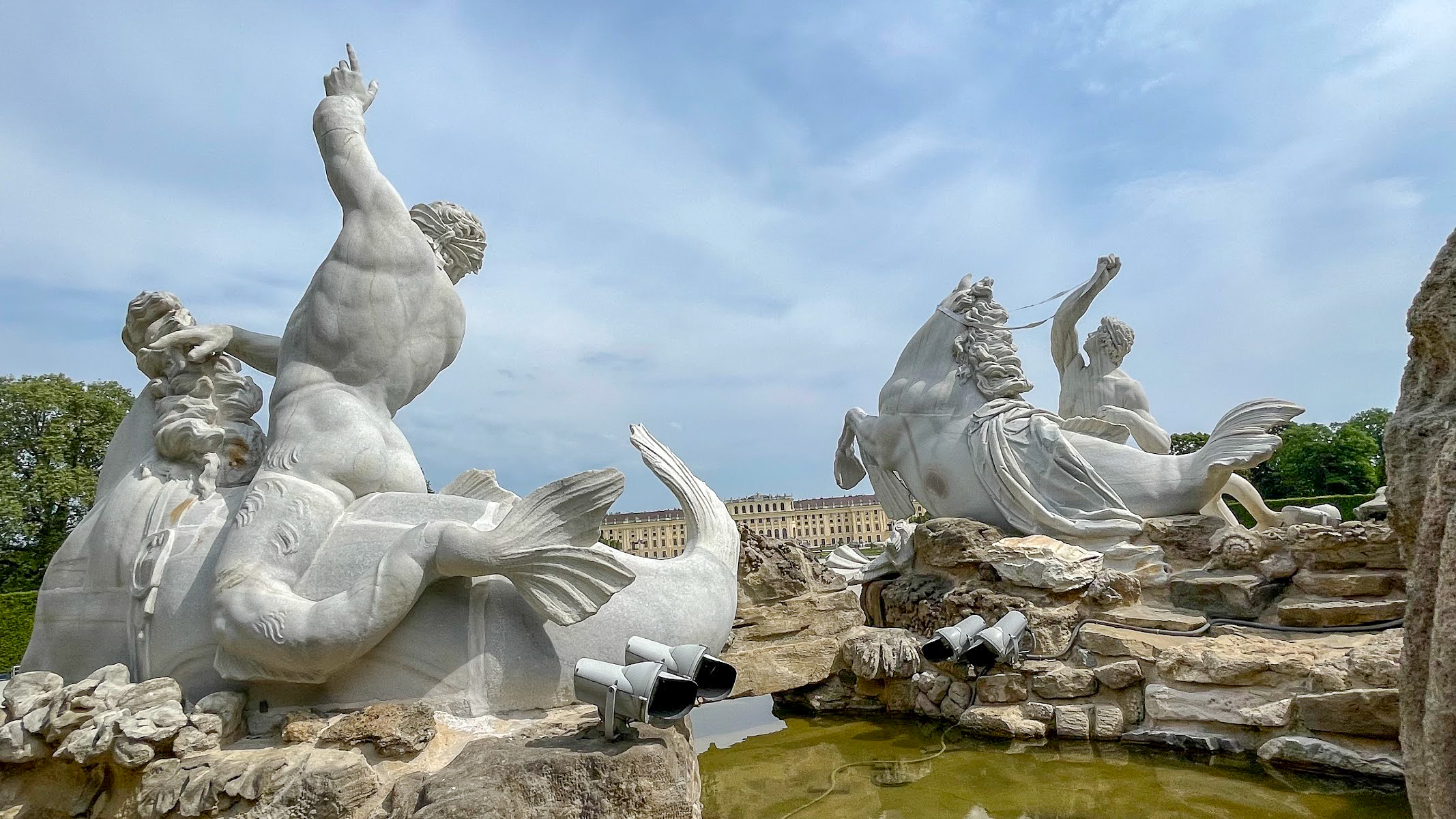

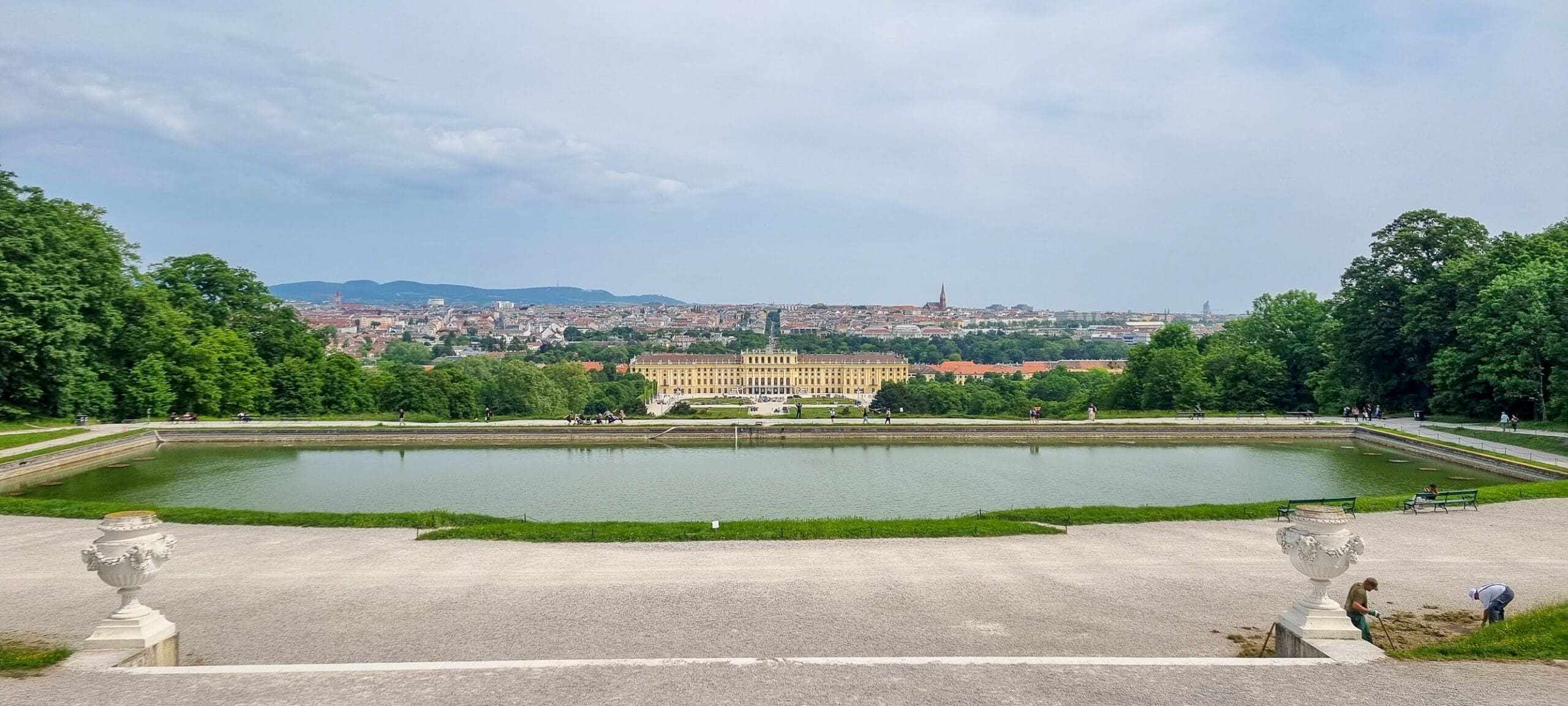
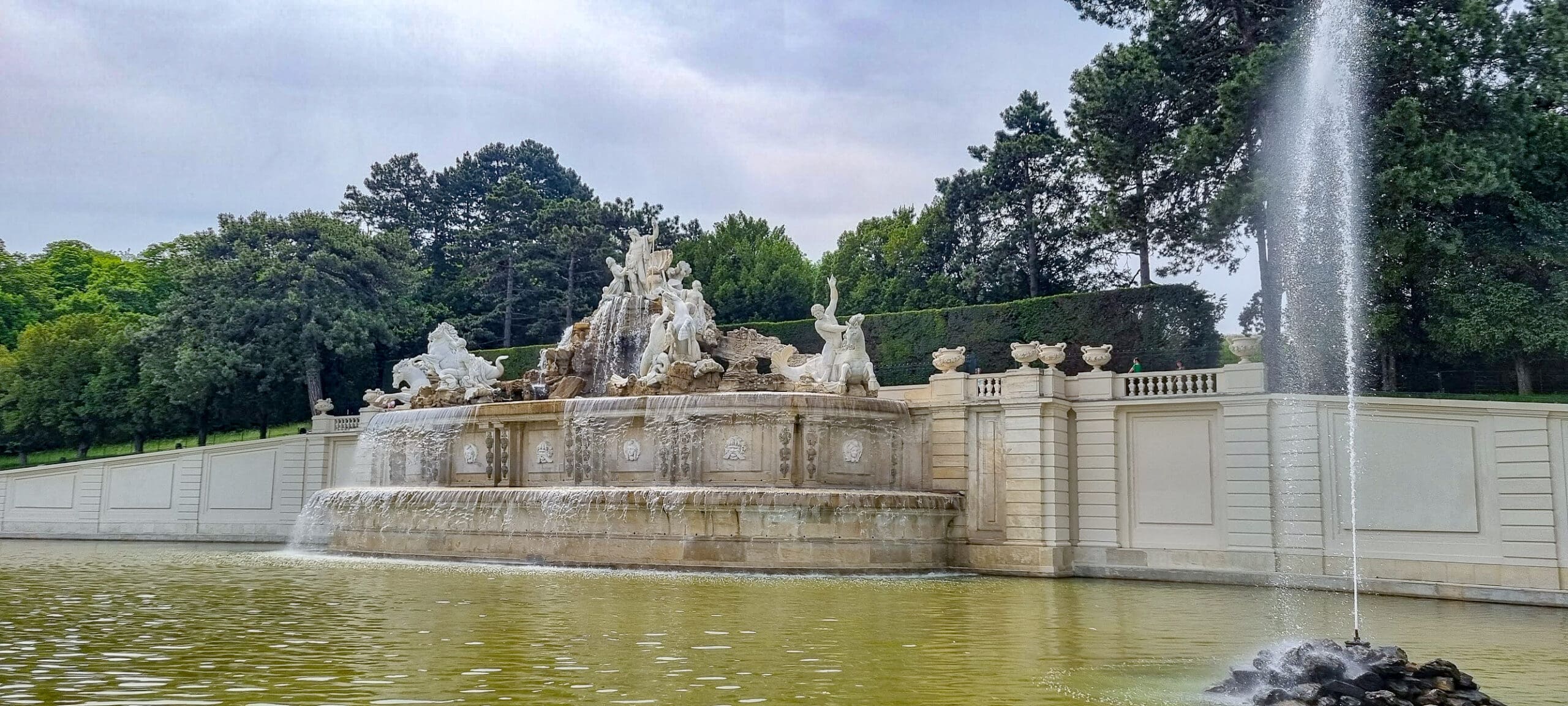
Schönbrunn Palace is one of Vienna’s most popular attractions so getting here when it opens is a good plan. The ticket office is a good ten-minute walk from the train station so build that walk into your timings.
St Stephens Cathedral
Vienna’s cathedral, the mighty, Gothic St Stephens, is the tallest church in Austria. Looking at the steep roof, you can see why. The roof is stunning, with patterns extending to the sky. It’s extreme slope heps snow to slide off in winter. There are 230,000 glazed tiles that make up the extreme zigzags and the coats of arms including the Imperial and royal double-headed eagle seen below. The tall tower is nicknamed “Steffl” and stands at 136m. You will have seen it in most of the views we have seen of the city. It is pretty mind-blowing to consider it was completed in the 1400s.
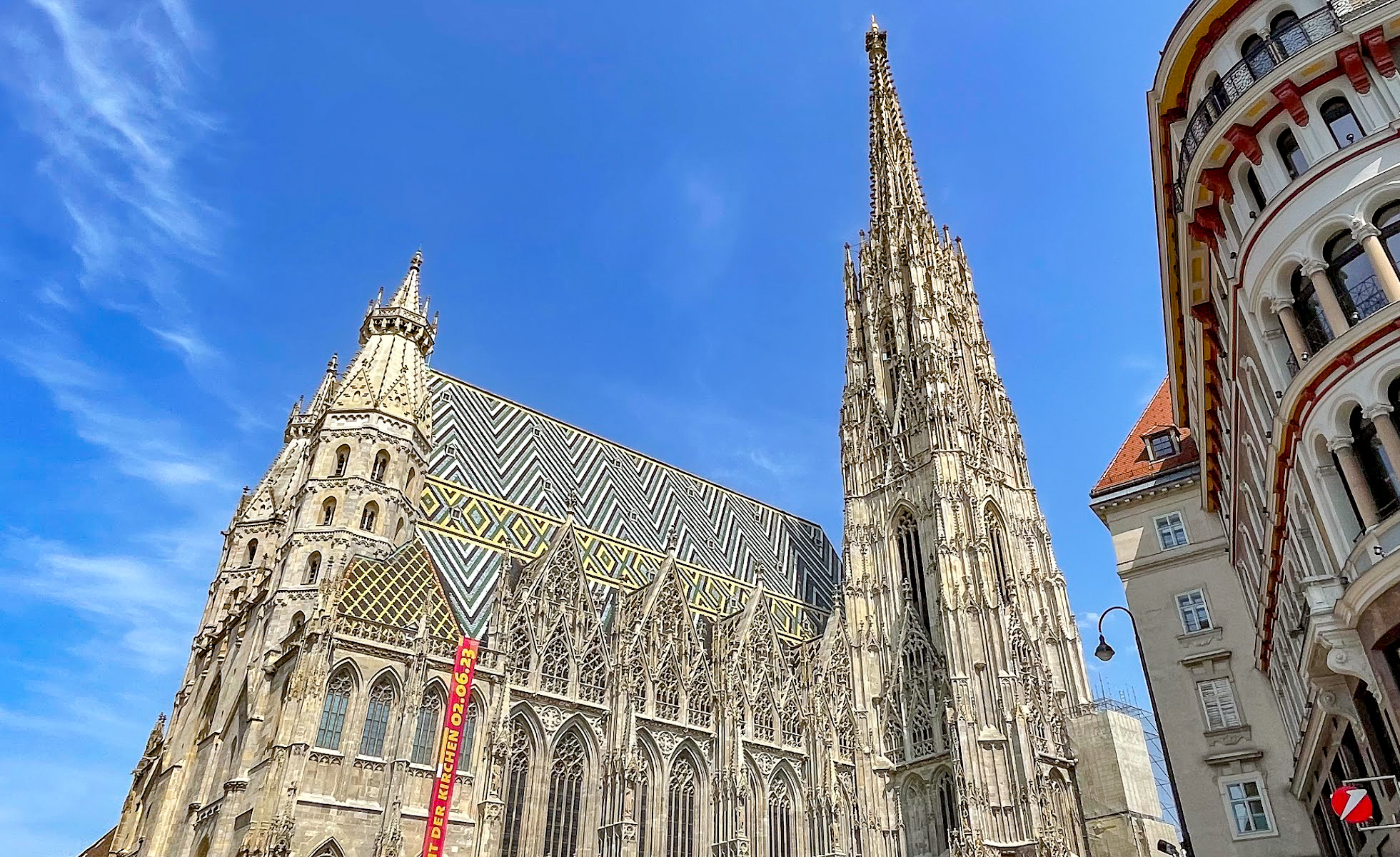


Before you head inside, take a little time to check out the door you are passing through. The Riesentor, (the Giant’s door) is huge and highly decorative.
Inside, the soaring ceiling is quite plain but the treasures that are around the naive are beautiful. There are so many carved flourishes and deep, dark paintings that is hard to know where to look. If you buy a ticket you can explore them up close. Without a ticket, you can wander down one side of the church and see the six chapels and the crypt. You can also climb the South Tower. It is 67m tall and the climb involves 343 steps. It is hard work but we love a view. (For a nice view of the church, stay tuned for a spot that has a lift coming next).
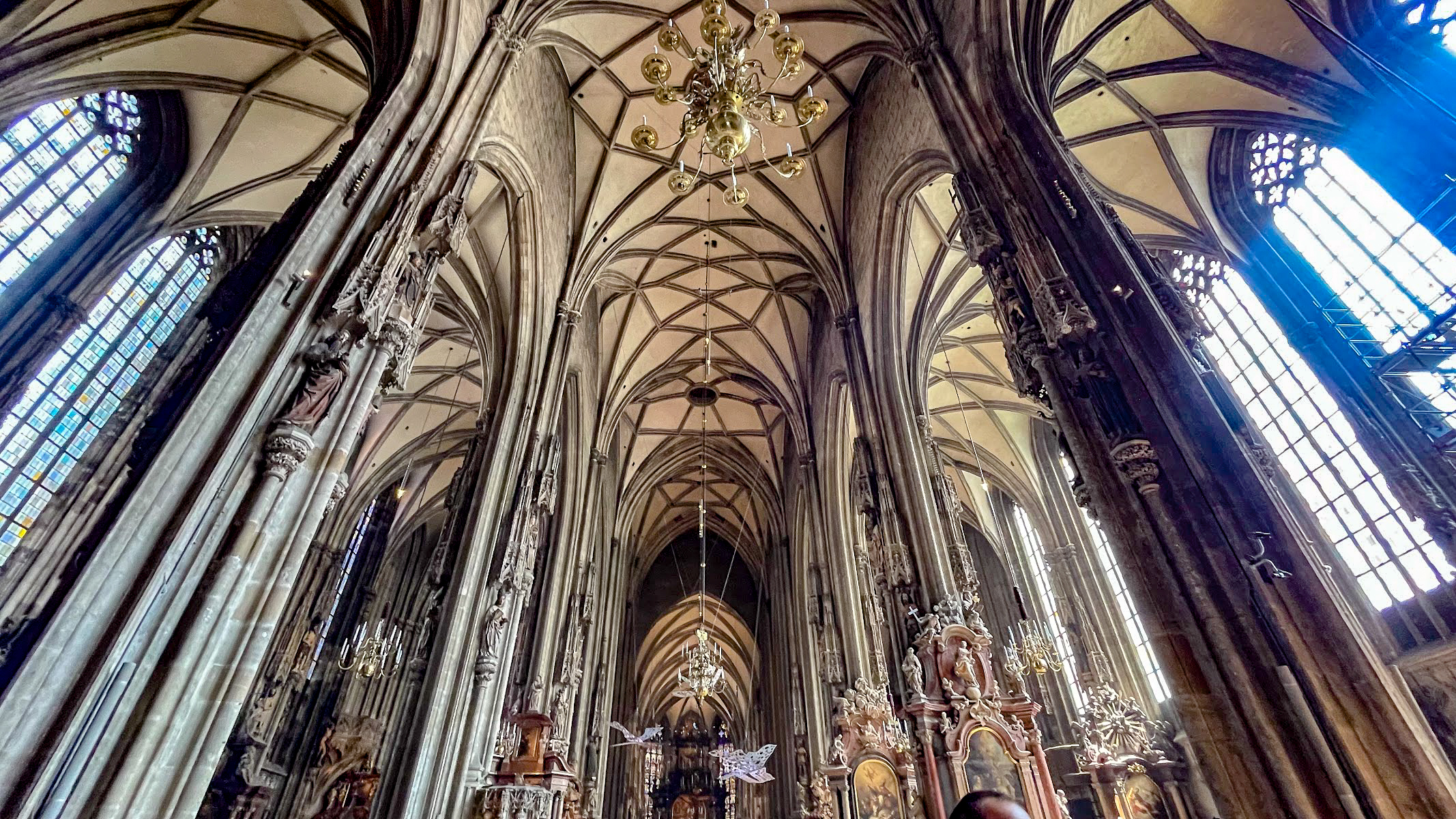

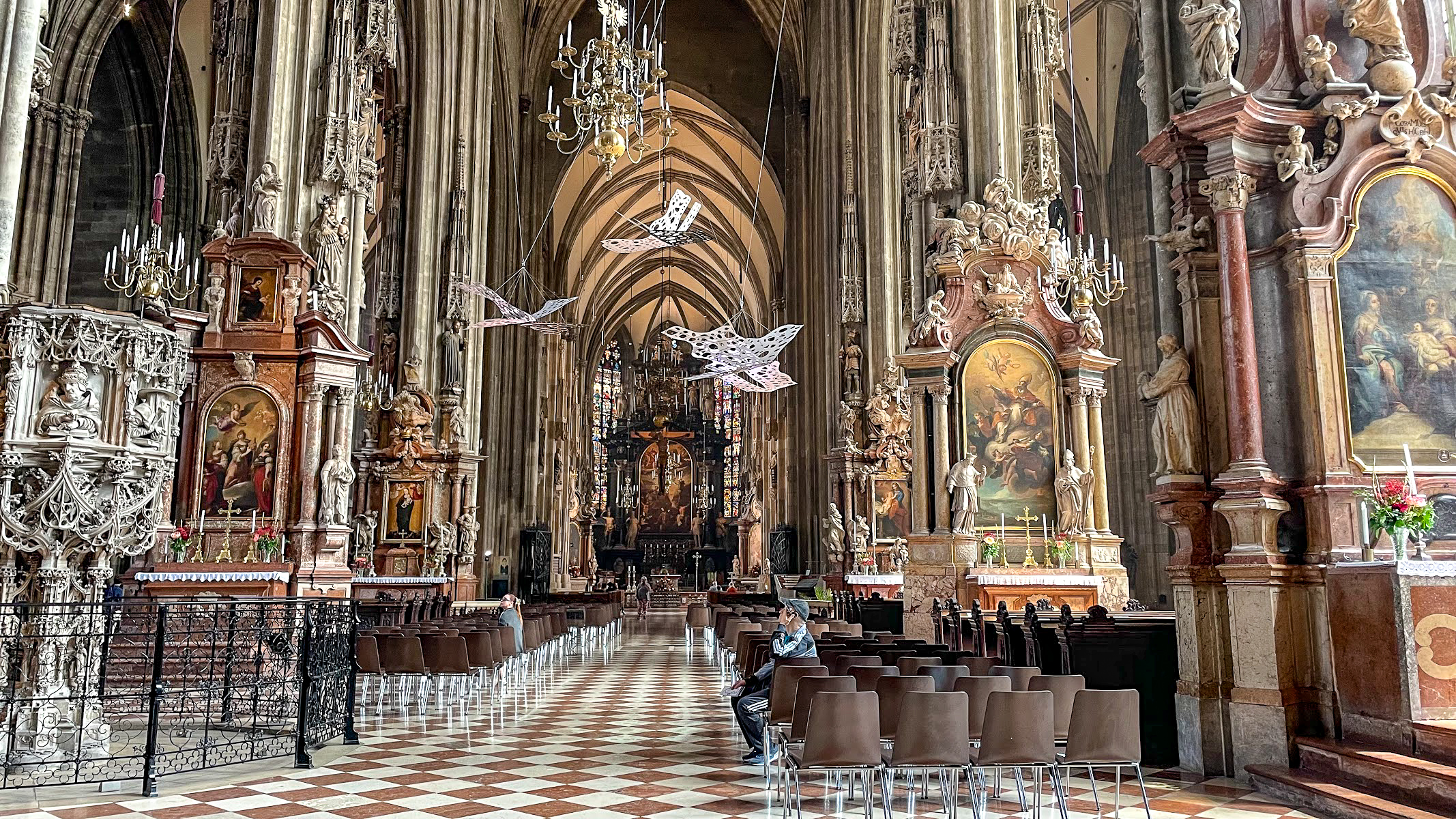
Lamee Rooftop Bar
For another perspective of the church, and a very overpriced drink, head two streets over to Lamee Rooftop Bar. Drink prices are almost as high as the bar, but the sun feels fantastic up here and the Aperol Spritz was a good one. (which is lucky because it is one of the cheapest cocktails). Of course, they have the normal sodas/soft drinks but also, some rather lovely homemade lemonades at just €5.50 so you don’t have to have boozy bevvies to have a fun drink. It feels like a place to see and be seen with a cool vibe and chilled house background beats.


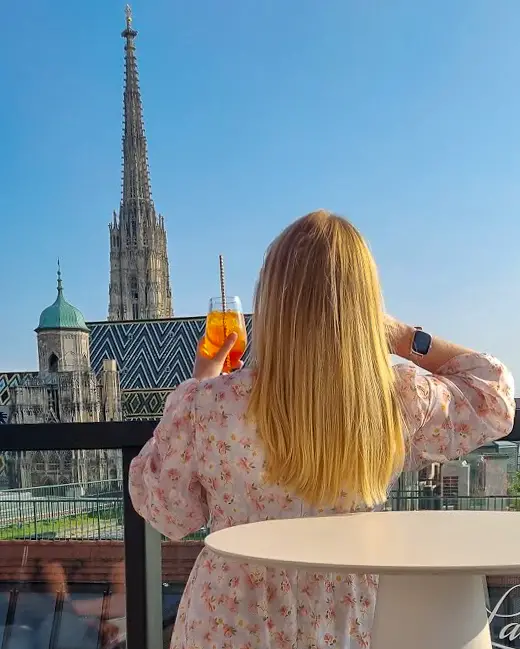
The Plague Column
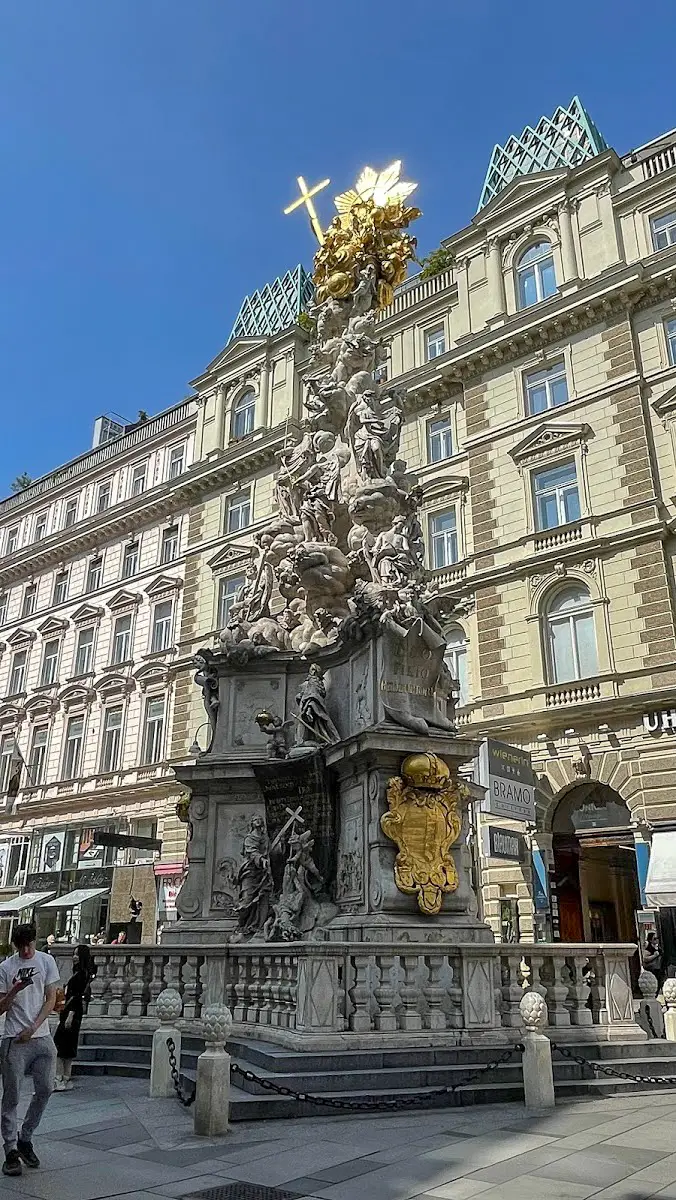
For something as dark as the black plague, the monument to it in Vienna is strangely cheerful. It was created in 1679 after a particularly bad breakout of the disease. The baroque artwork features men on the lowest level, angels on the second and the holy trinity at the top.
Buffet Trzesniewski
Buffet Trzesniewski Dorotheergasse is one of those food spots that is simple perfection. There is a counter stuffed full of little rye bread open finger sandwiches, Belegte Brote. The founder Franciszek Trzesniewski, came to Vienna from Kraków and set up his cafe in 1902 but this idea has become thoroughly Viennese. You can choose from 21 sandwich varieties. In 2023 the prices were 5 for €8.50 or 10 for €17. You make your way along the counter, pointing at the ones you would like and the lovely ladies will pop them on your plate for you. The majority of options are meat or fish-based but there are almost enough to fill 10 slots without any repeats. Along with the sandwiches, you can get a pfiff (a “whistle”) of beer which is around 200ml for just €1.70 or a little wine spritz for €3.60. Once you have paid for your drink, make your way to the other end of the counter and hand your chip in and you’ll get the beverage.
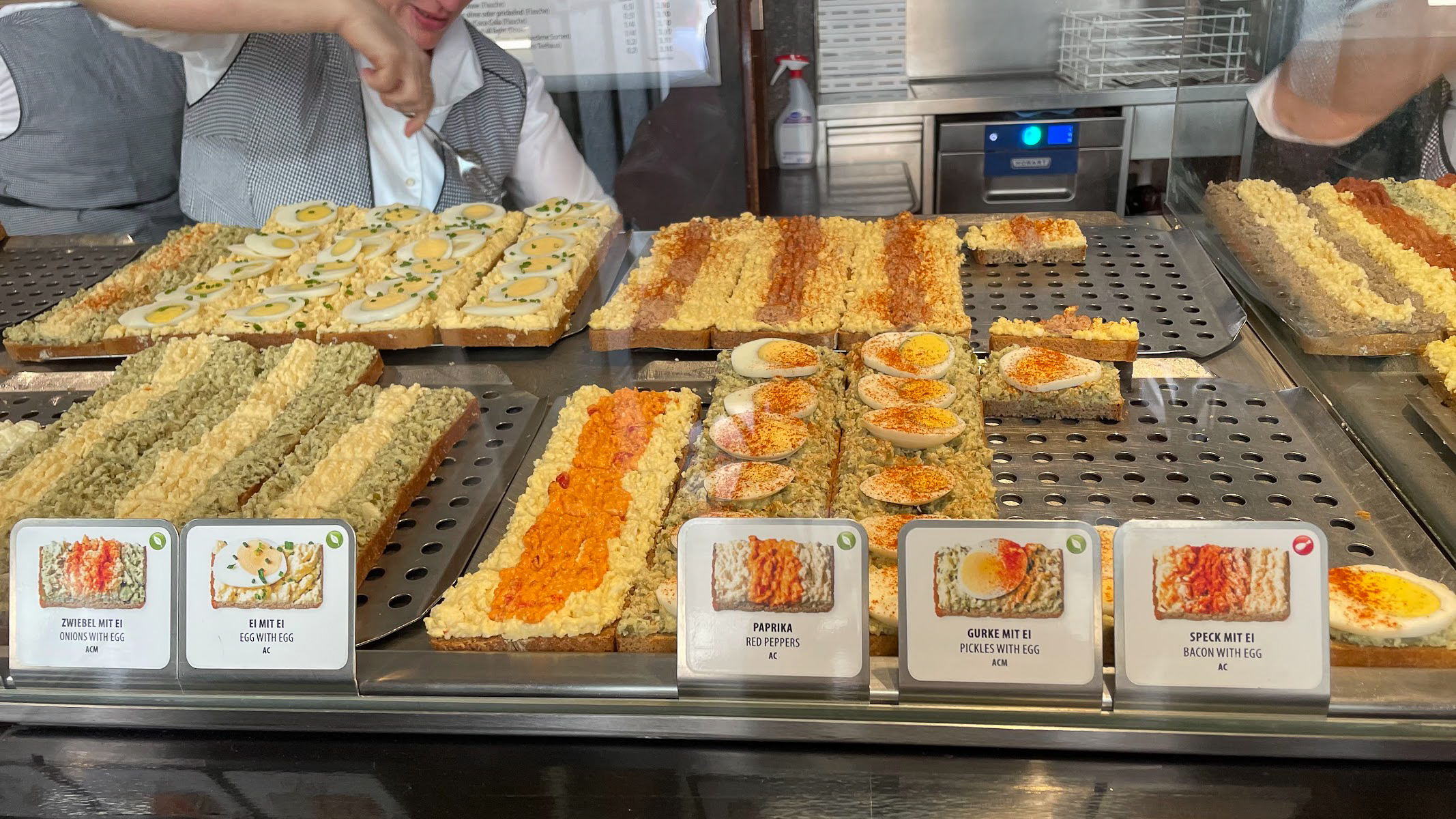
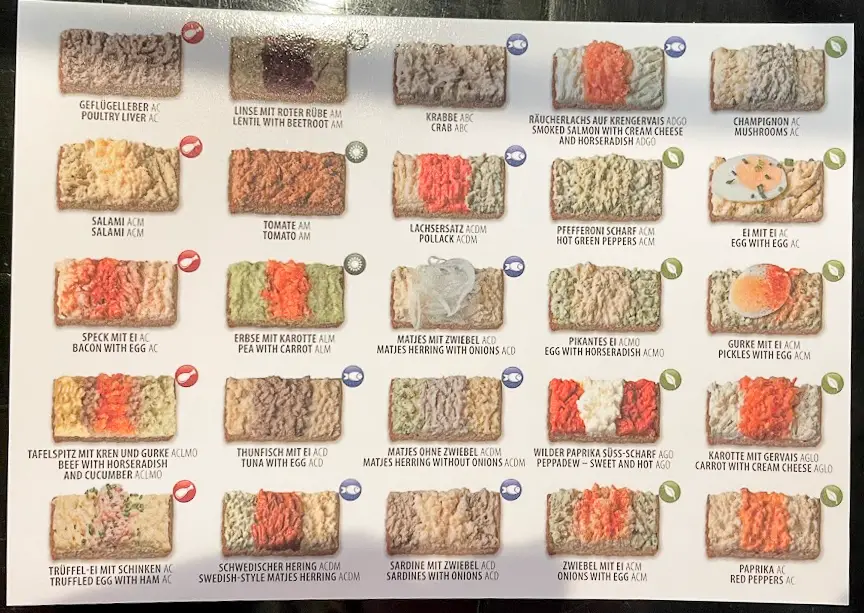
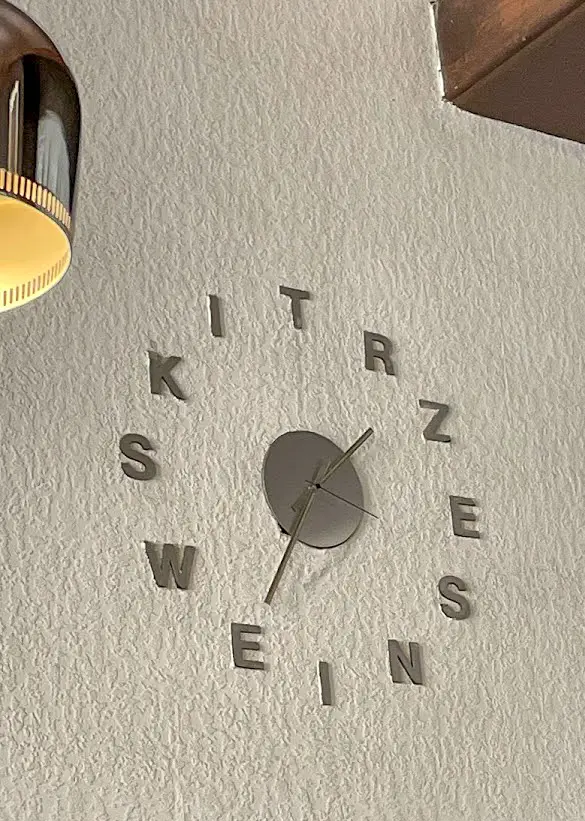
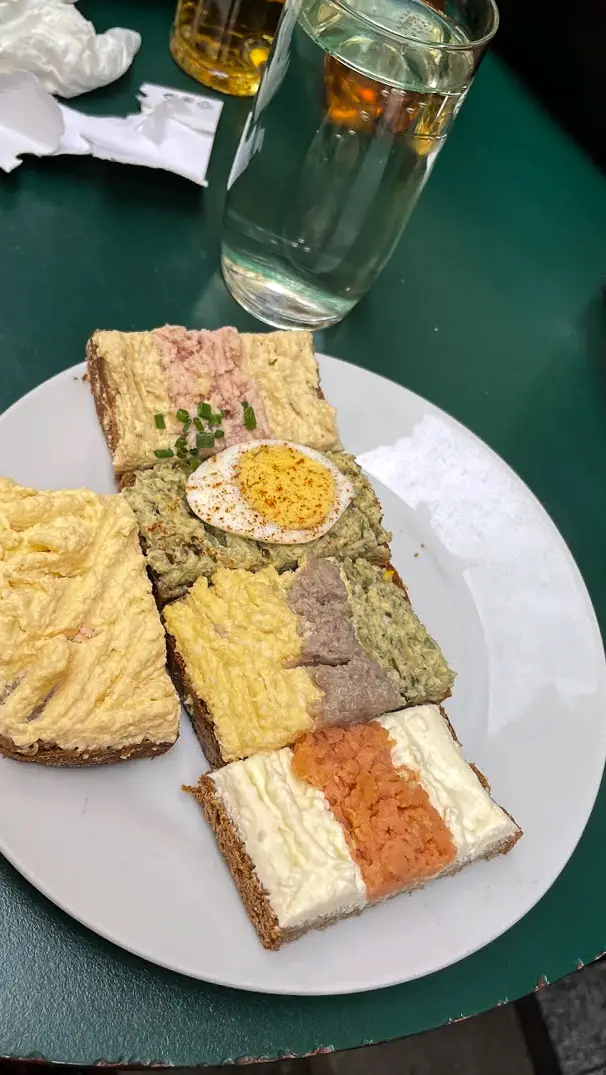
The Spanish Riding School
Vienna is home to the oldest riding school in the world. It has been training world class riders for over 450 years. Pop your head into the stables (look for the point called Advent in der Stallburg on Google Maps) before heading to the Riding School. There are a few different ways to visit the school. Some people like to see where the horses live, some like to see them in action. To do both, you’ll need two tickets.
The rehearsal sessions are a pretty unique attraction. You get to enter the Winter Riding Hall, the main training space for the beautiful white and grey Lipizzaner horses. There are two sessions with 6-8 horses in each. The horses and riders concentrate on their own training, running drills, trotting, cantering, dressage steps and some more advanced skills. Their practice session is all set to a classical music soundtrack. The riders are immaculately dressed in their Spanish Riding School uniforms and you can see the relationships they have with their equine charges. If you love horses, you will be spellbound.
You will need to book your tickets well in advance as every session sells out. Of course, you can come to a performance in the evening but this is a cheaper way to see it.
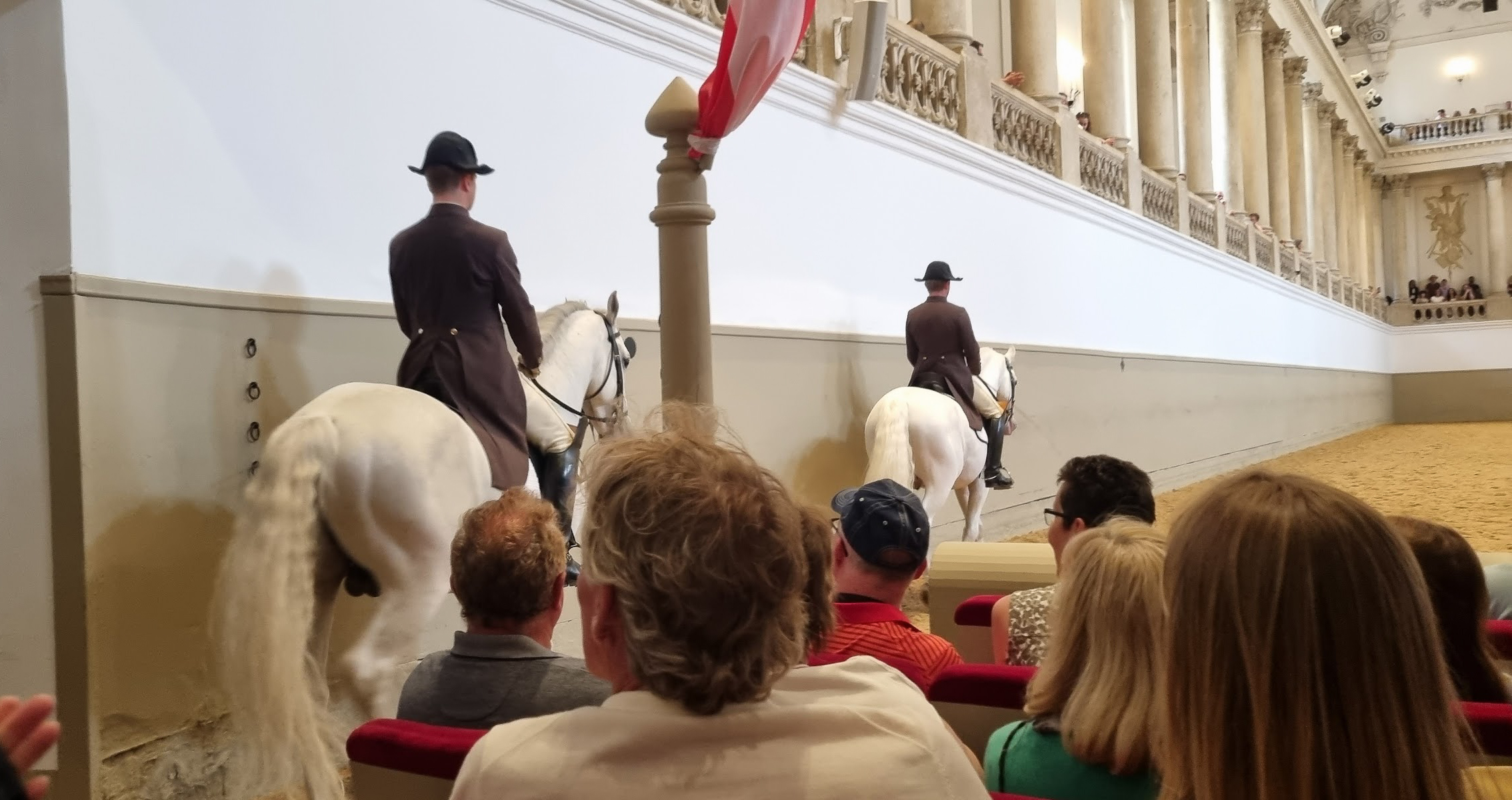
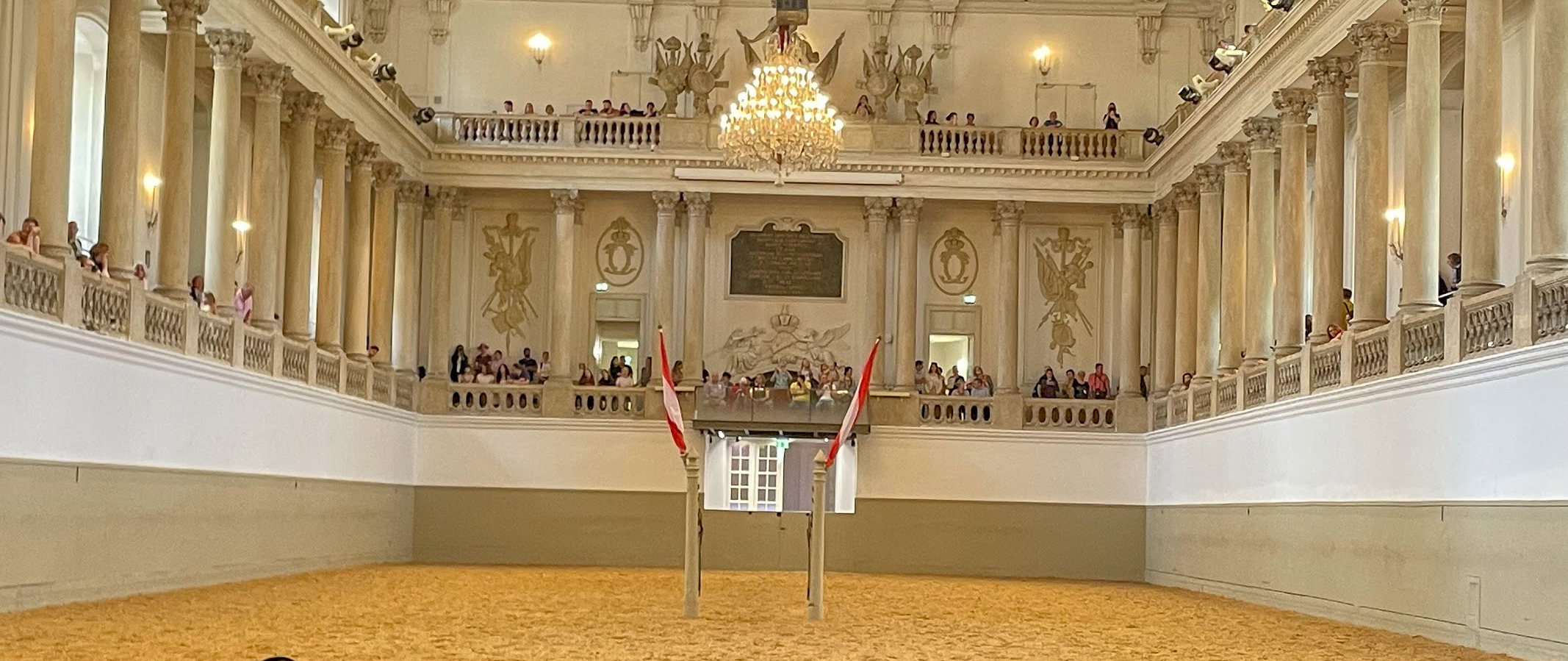
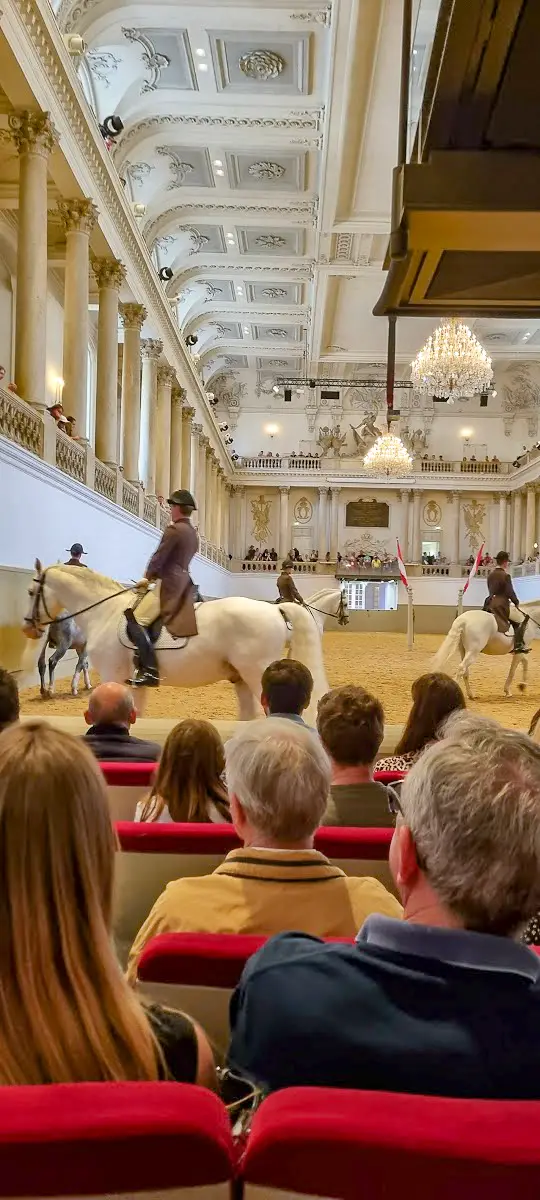
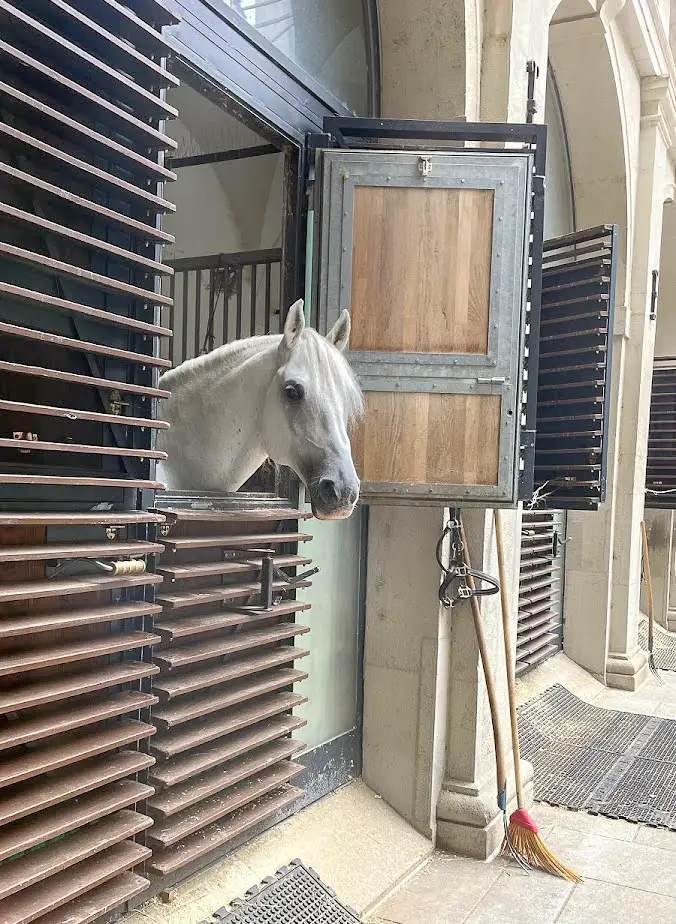
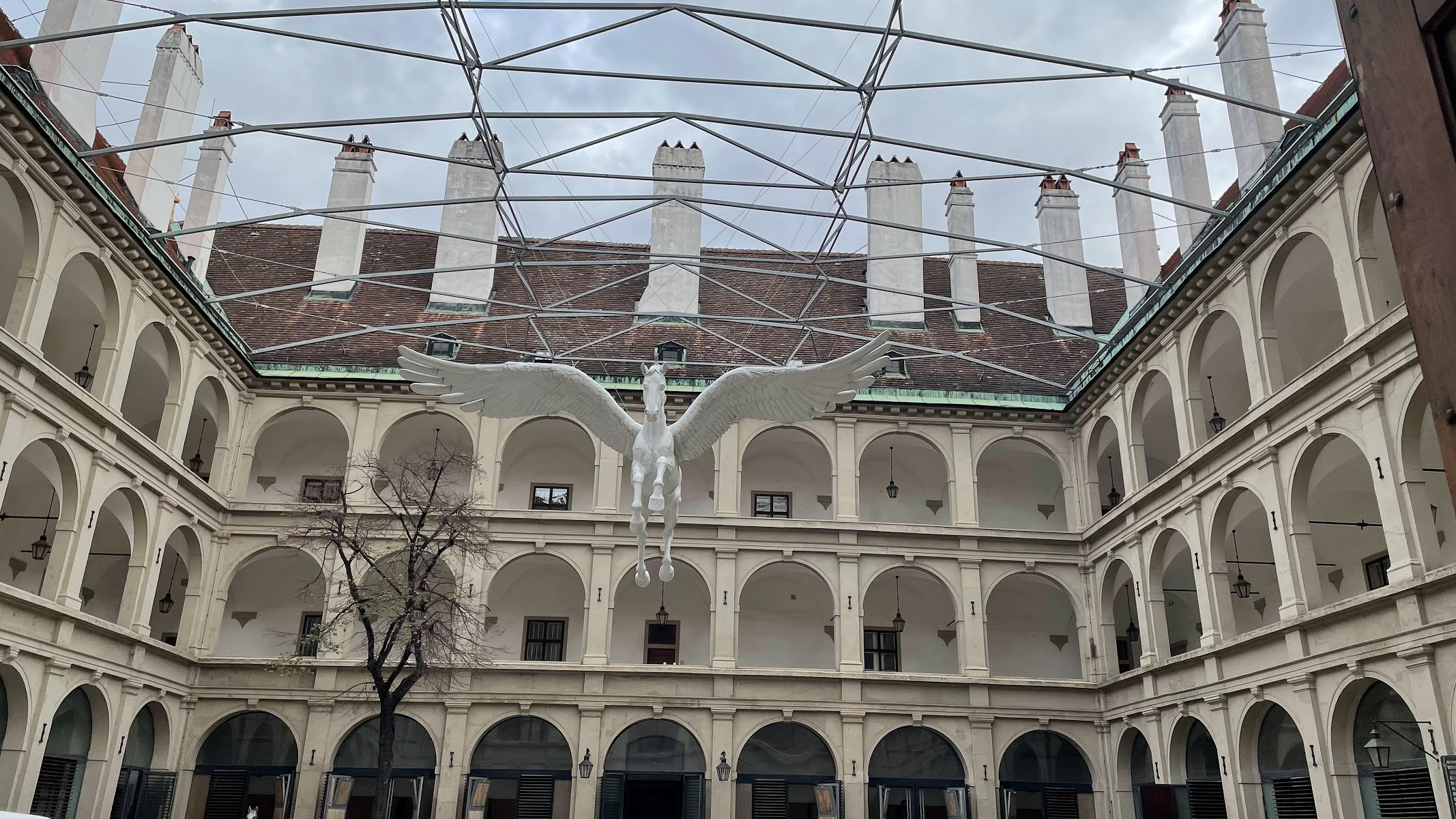
Demel
Vienna has a rich history of cafe culture, replete with rich cakes. The most iconic cafe is our next stop. Demel has been serving up many a melange since 1789. (A melange is a bit like a cappuccino…but not. Austria has its very own coffee variations and you can learn more about them here). This is the cafe that served the first Sachertorte, Vienna’s most famous cake. Sachertorte is layers of dark chocolate sponge and apricot jam, covered in beautiful chocolate icing and served with unsweetened cream. It is rich heavy, and superb! The cake was created by Franz Sacher who took his recipe when he setup his own establishment and that is the other best spot to try it. If you don’t fancy one of those there is a huge selection of cakes, pastries and patisserie to choose from.
Did you know? The reason breakfast pastries are called viennoiserie is because many of the most famous ones aren’t French, but Austrian! Croissant, pain au chocolate pain au raisin and more are from Vienna….so maybe get a croissant!
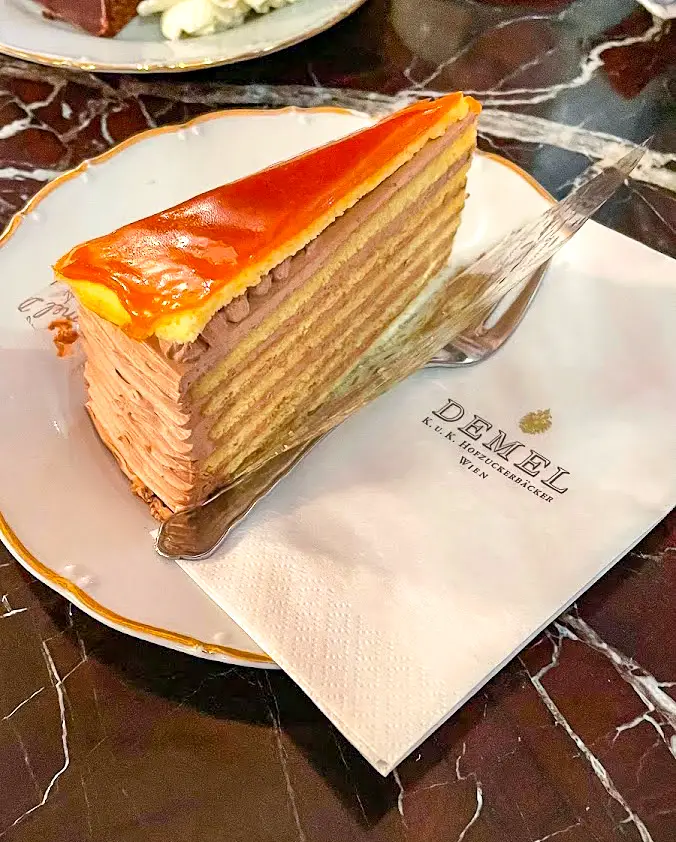

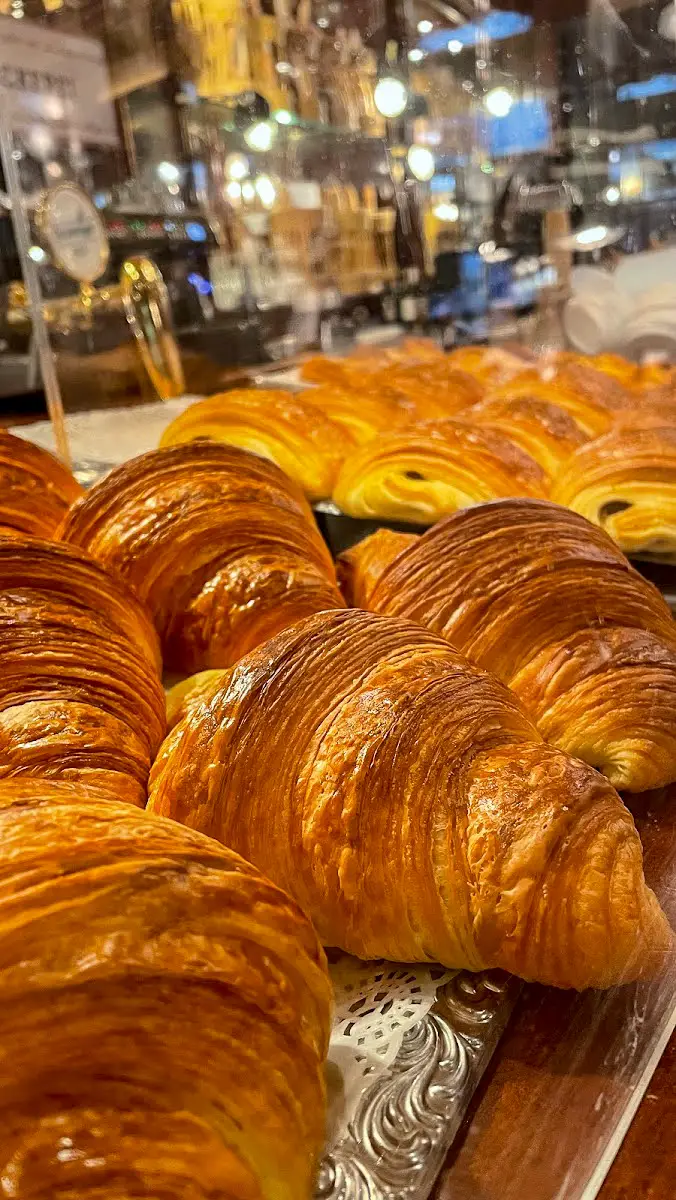


Prater & The Wiener Reisenrad
Vienna’s giant Ferris wheel, the Wiener Riesenrad has stood in Prater Park since 1897. It gives visitors great views of the city and the theme park below with a huge dose of vintage charm. The wheel may only be 65m high (half the size of the London Eye) but its slightly swinging carriages and clear Victorian mechanism make it seem much more fun. In fact, its iconic wooden carriages are so well known that have been featured as the setting for dramatic scenes in two Hollywood films, The Third Man and James Bond! A trip around the wheel takes around 15 minutes and costs around €15 (some easy maths there for you). The Prater theme park has no entrance fee. Instead, you pay for rides individually. This means you can spend as little or as much time in the park as you like.
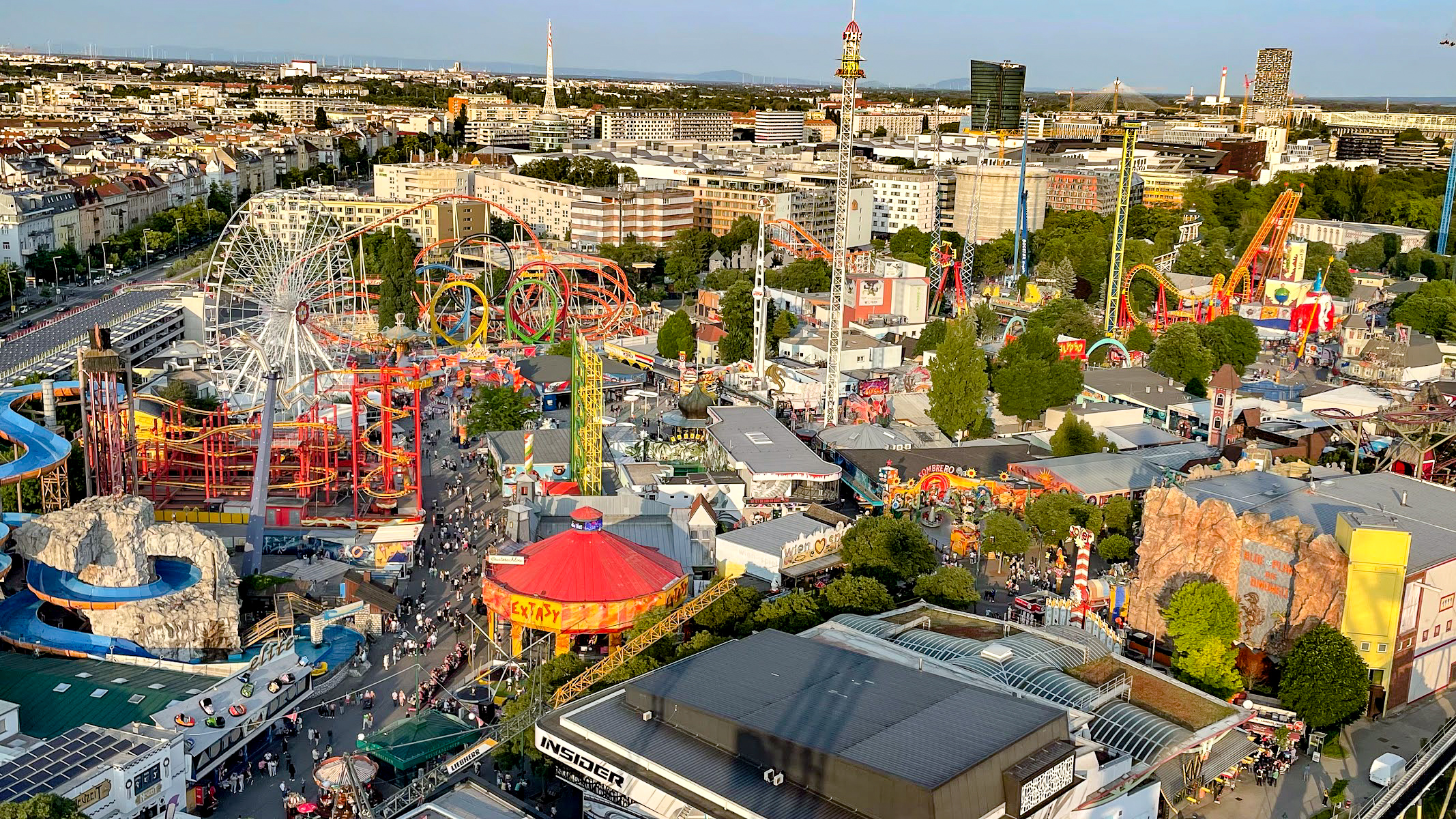



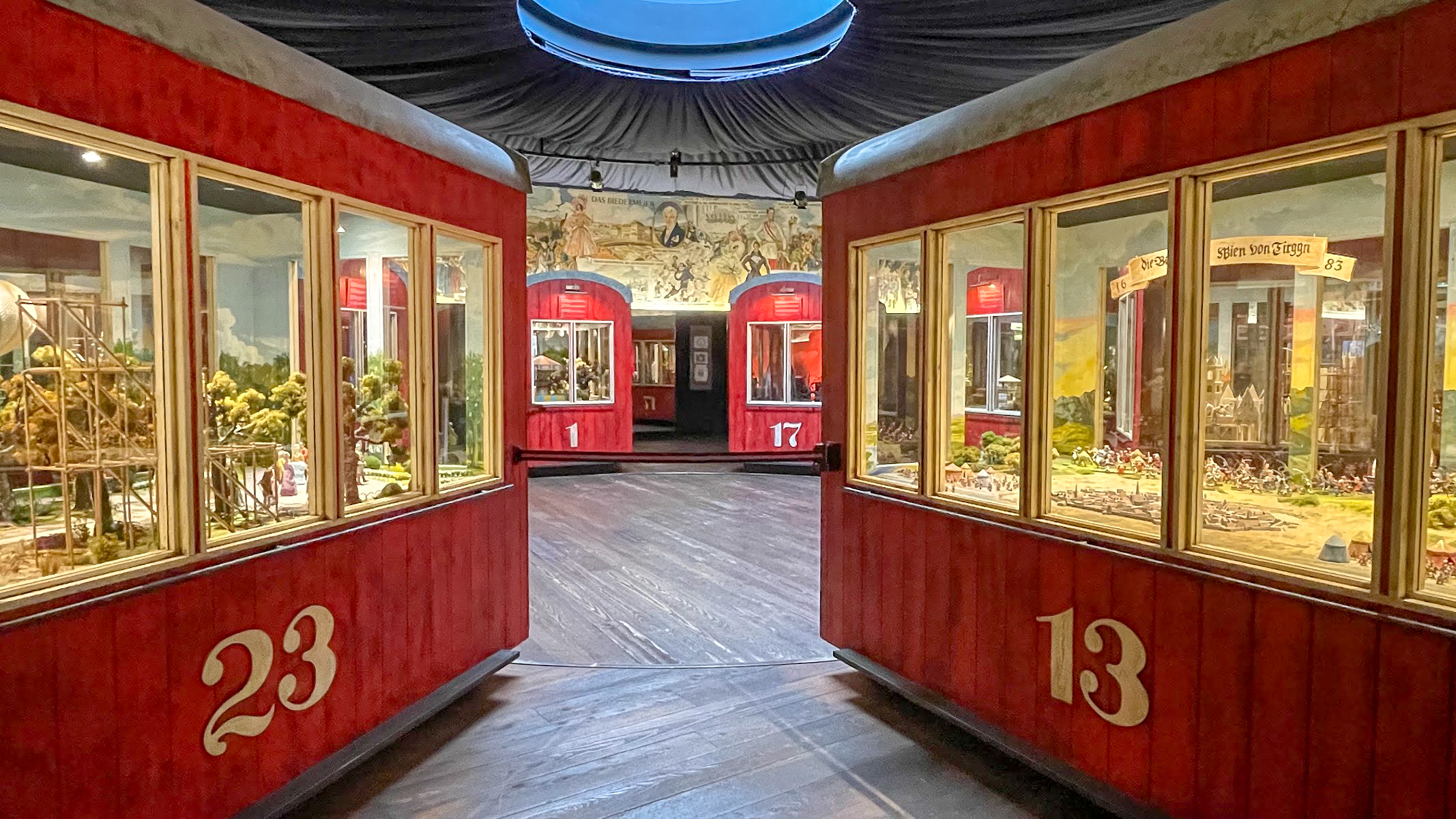
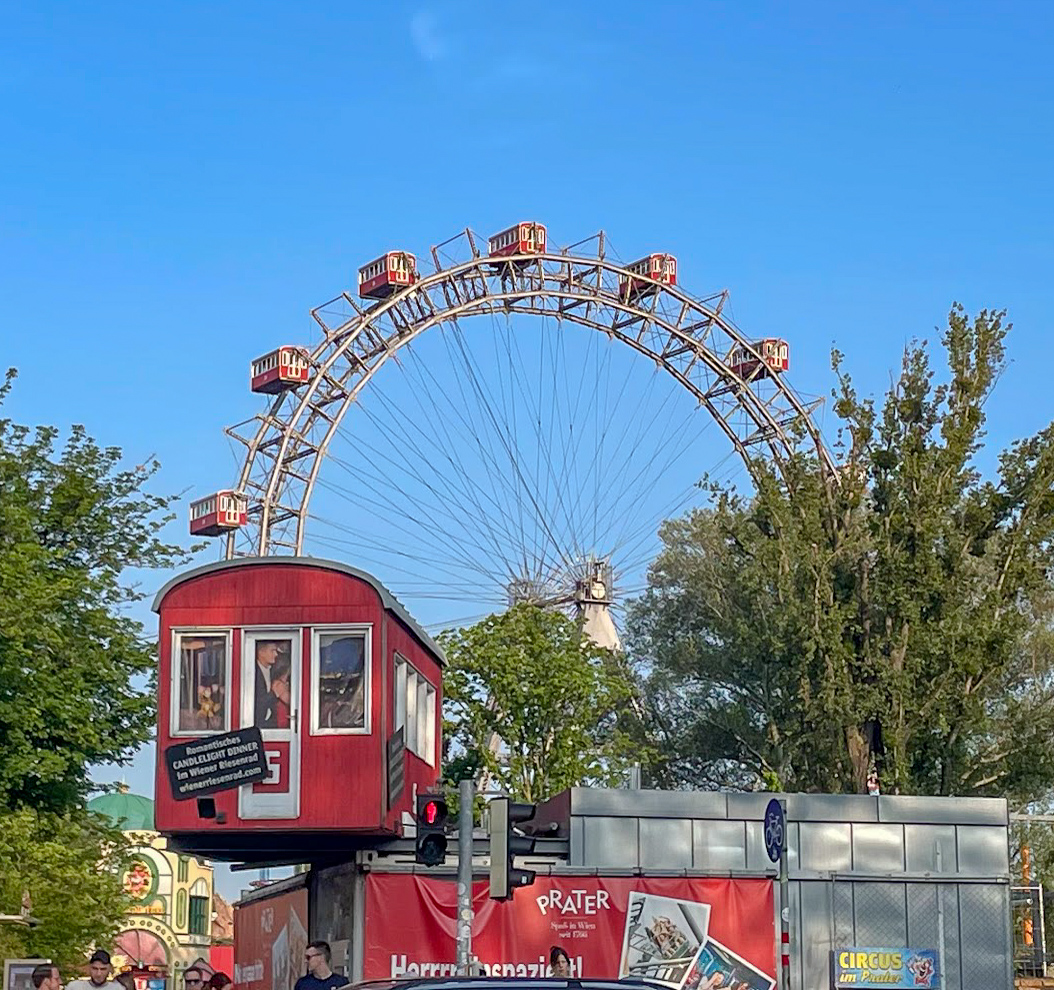
Bitzinger Wurstselstand
On the way out, towards the U-Bahn station, you will find a small stand on the right. This unassuming sausage stand isn’t your average fast food pot. This is one of Vienna’s iconic wurstselstands. There’s a more famous branch of Bitzinger Wurstselstand in Albertina but it always has a long queue and no seating. On the other hand, this one has chairs, tables, leaning spots and a much shorter wait. There is a large selection of sausages but those in the know opt for the Kasekrainer. (Kase means chees in German which gives you a hint to its USP. This sausage has little chunks of cheese in and although this might sound weird, it just makes it really juicy and delicious! You can also order a bottle of champagne to sip as you sausage which is thoroughly novel…and very tasty.
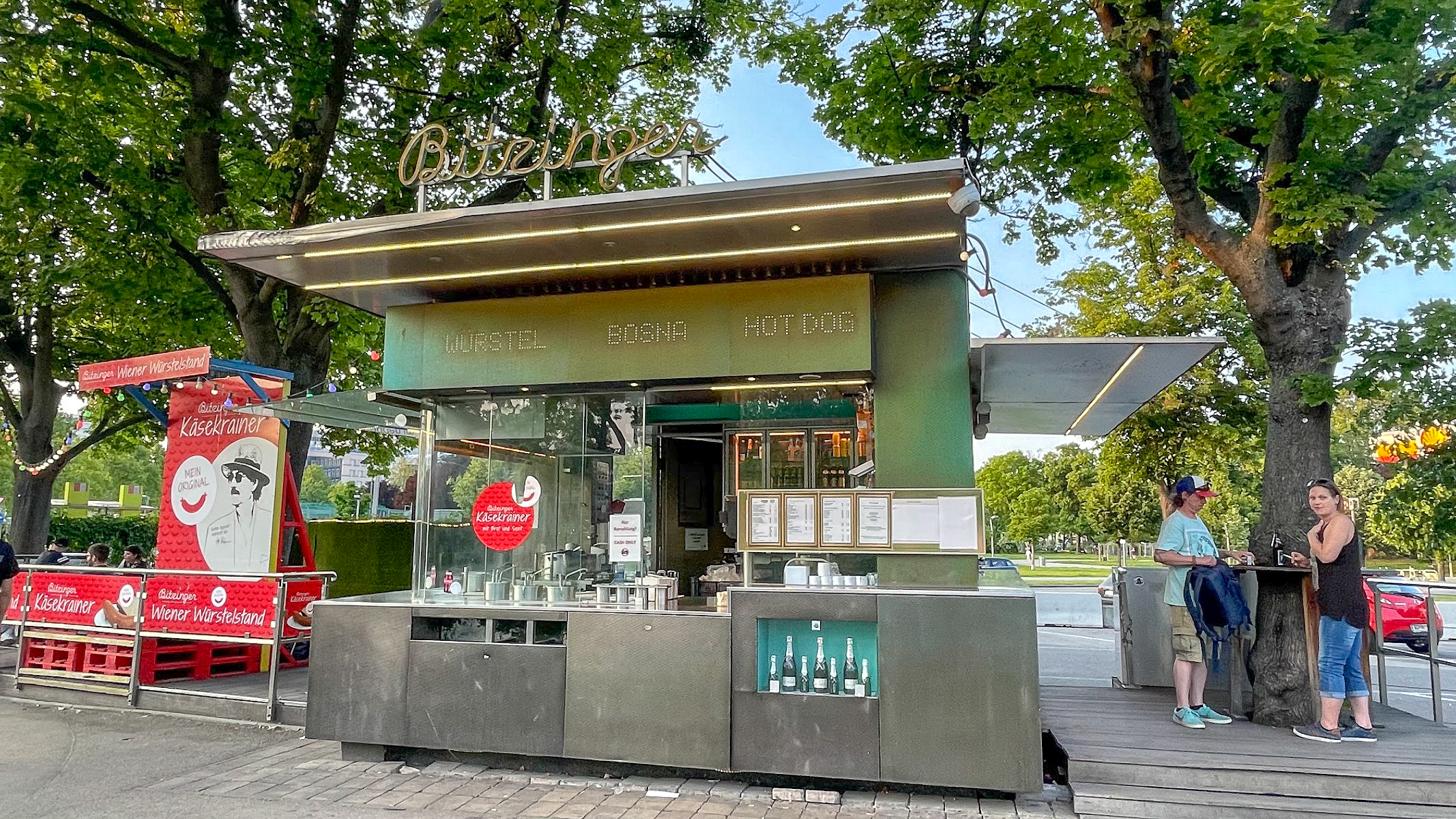


Final Thoughts on Your 2 Days in Vienna
This itinerary for 2 days in Vienna takes in the city highlights, running around the Ringstrasse and through the centre. From Vienna’s grandest palaces to its humblest eating establishments, this weekend in Vienna has something for everyone to enjoy. Yes, there is more to see and we will be back for sure! See you there.
Rosie xx

